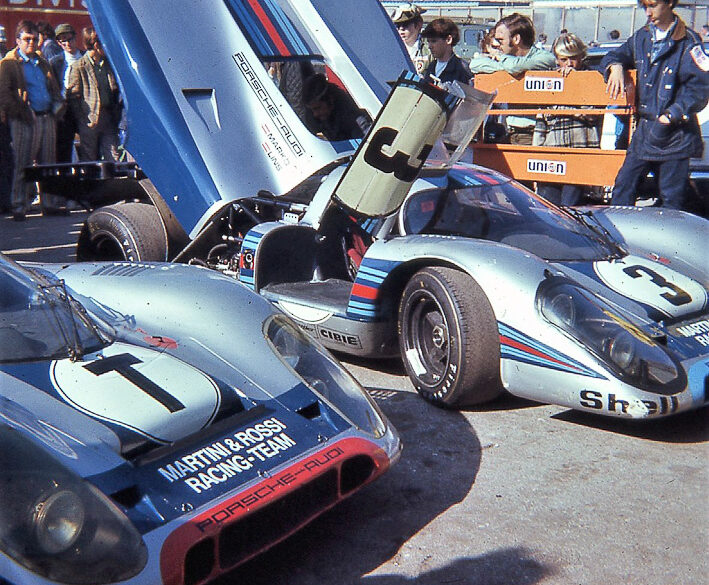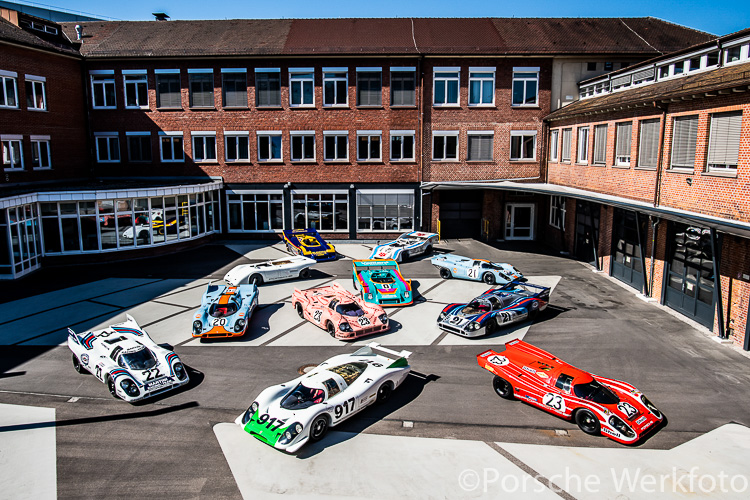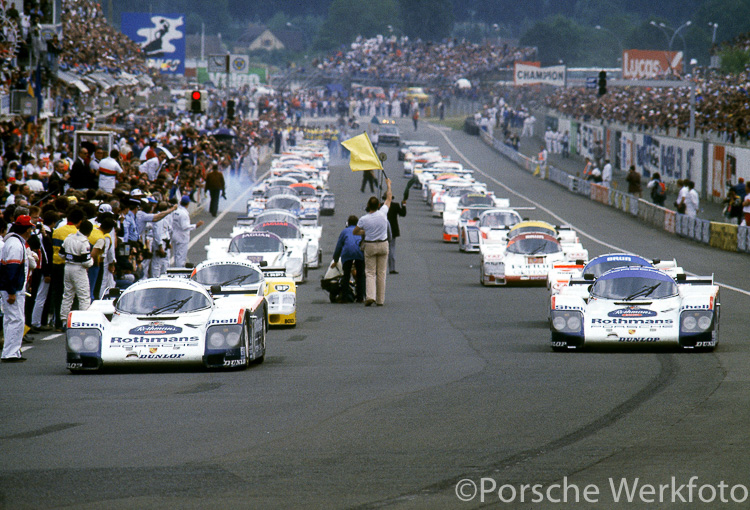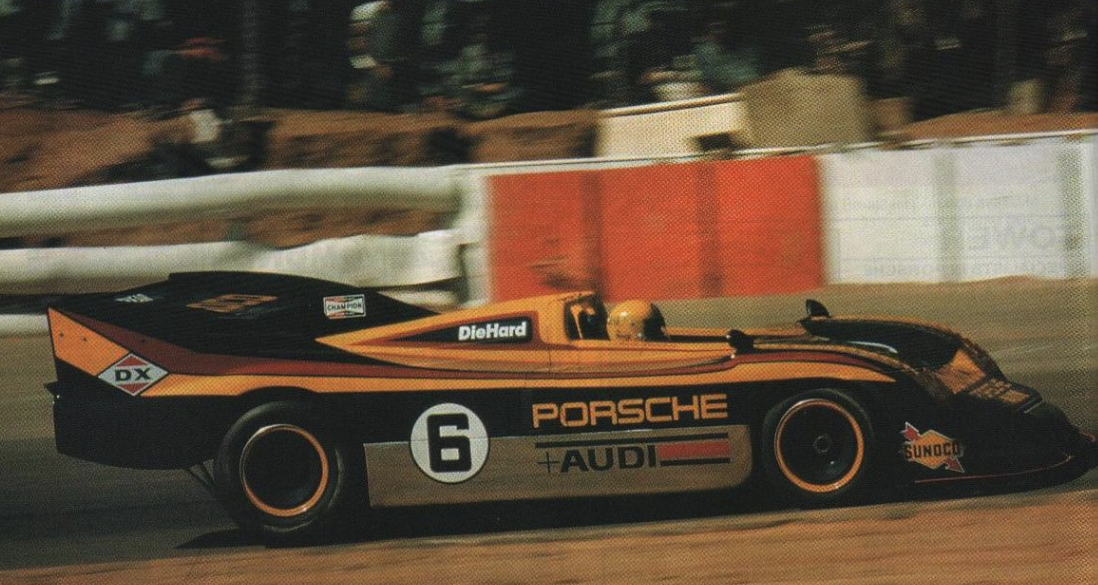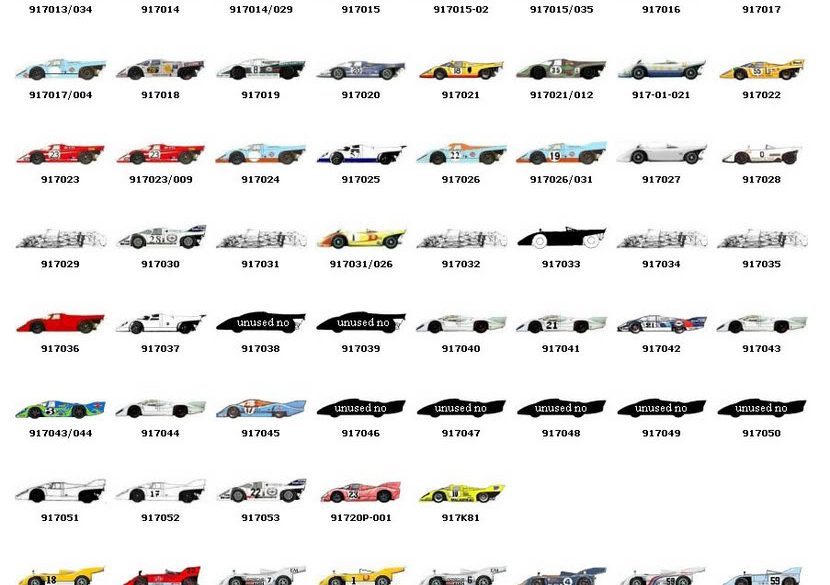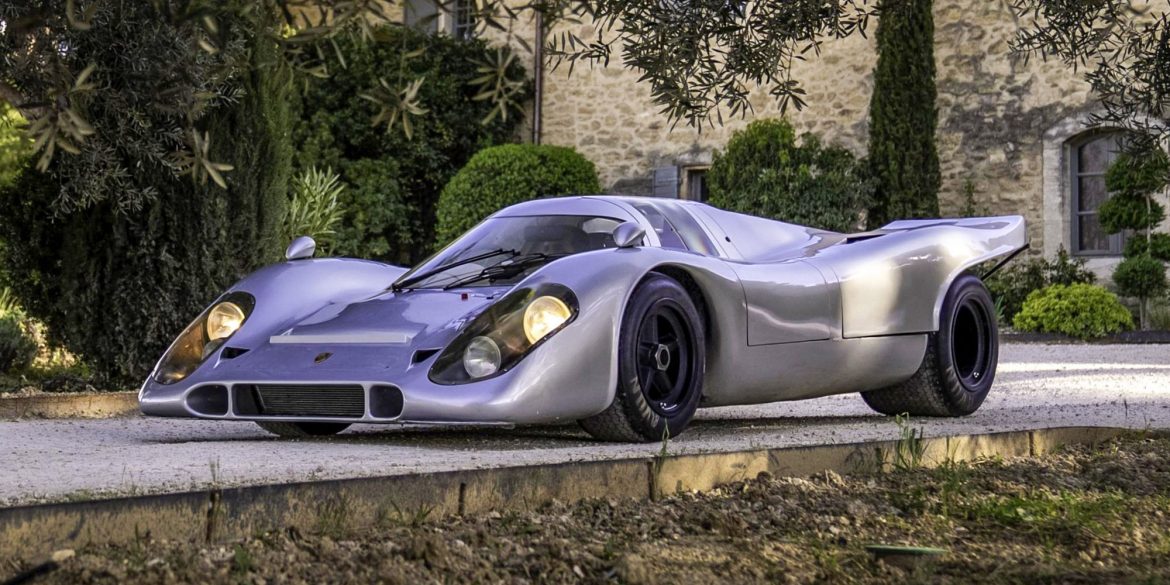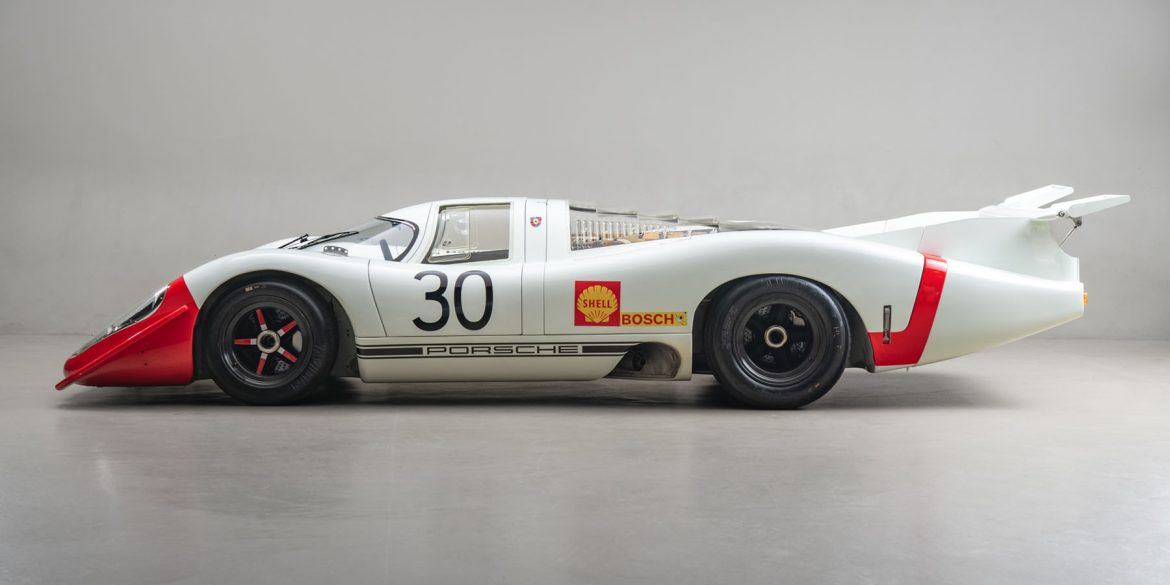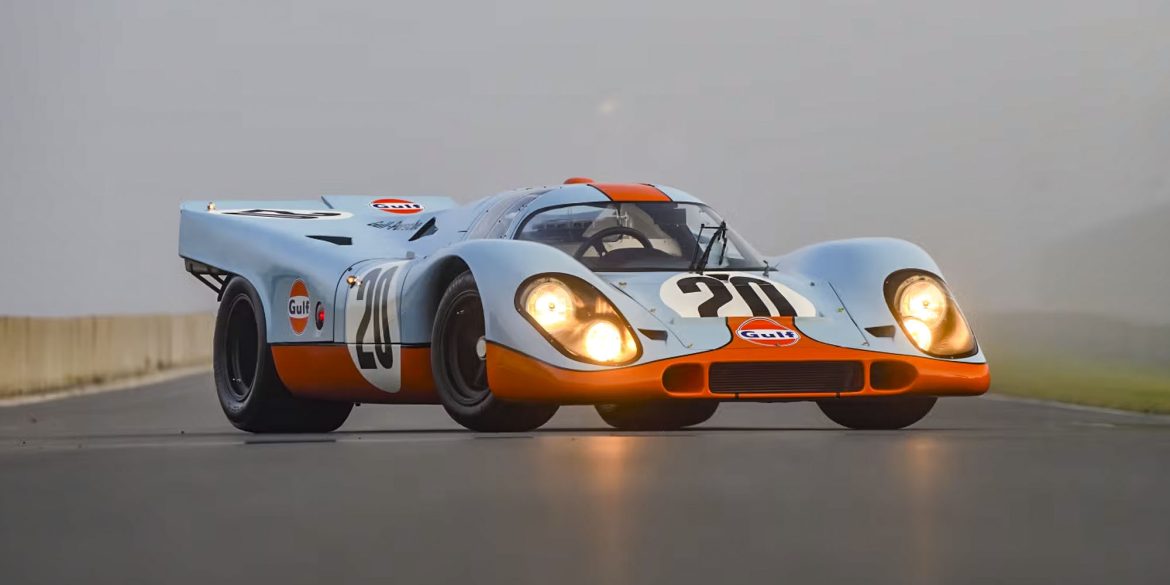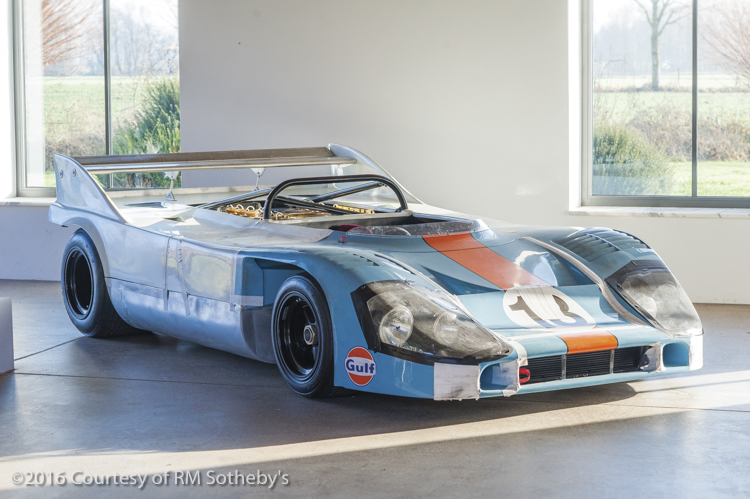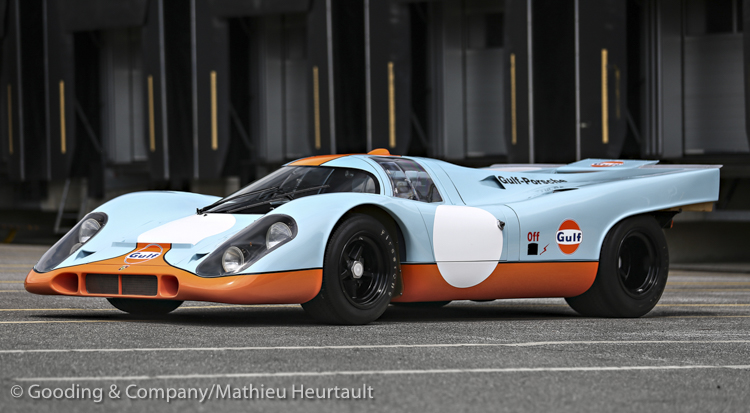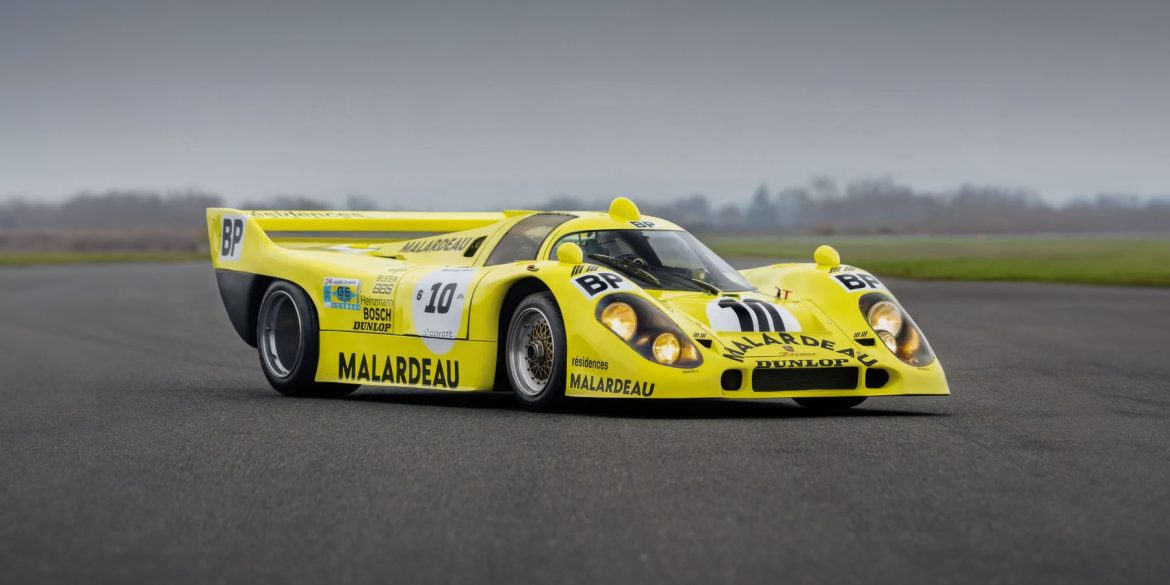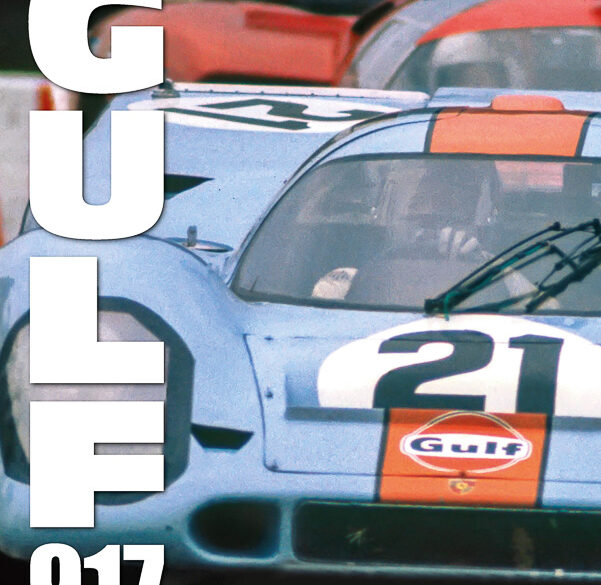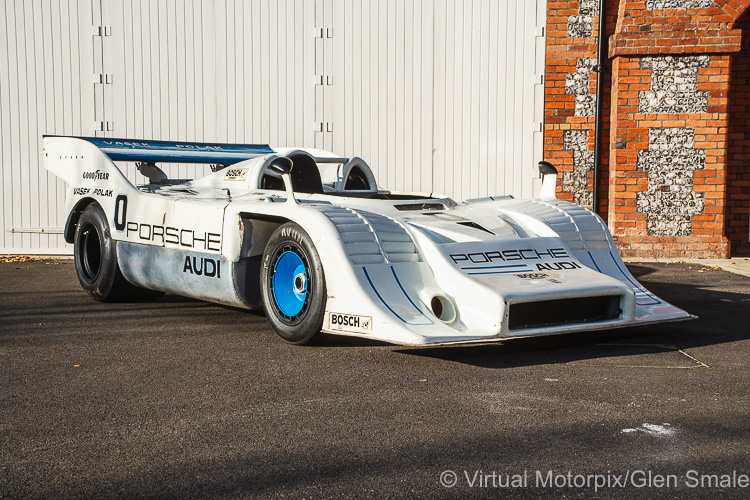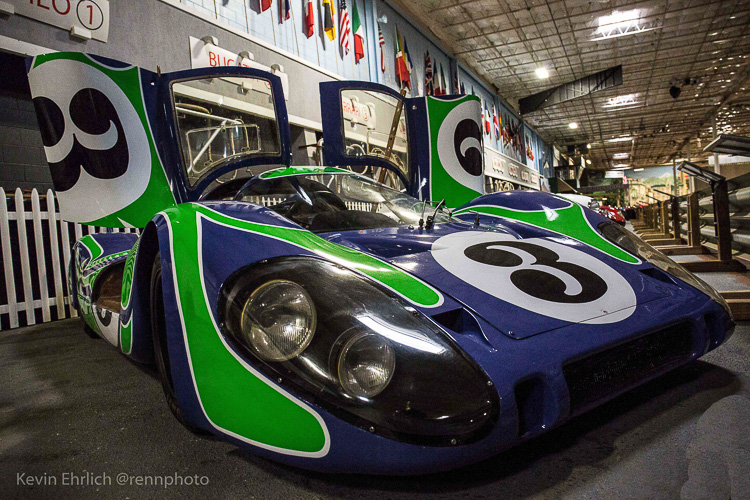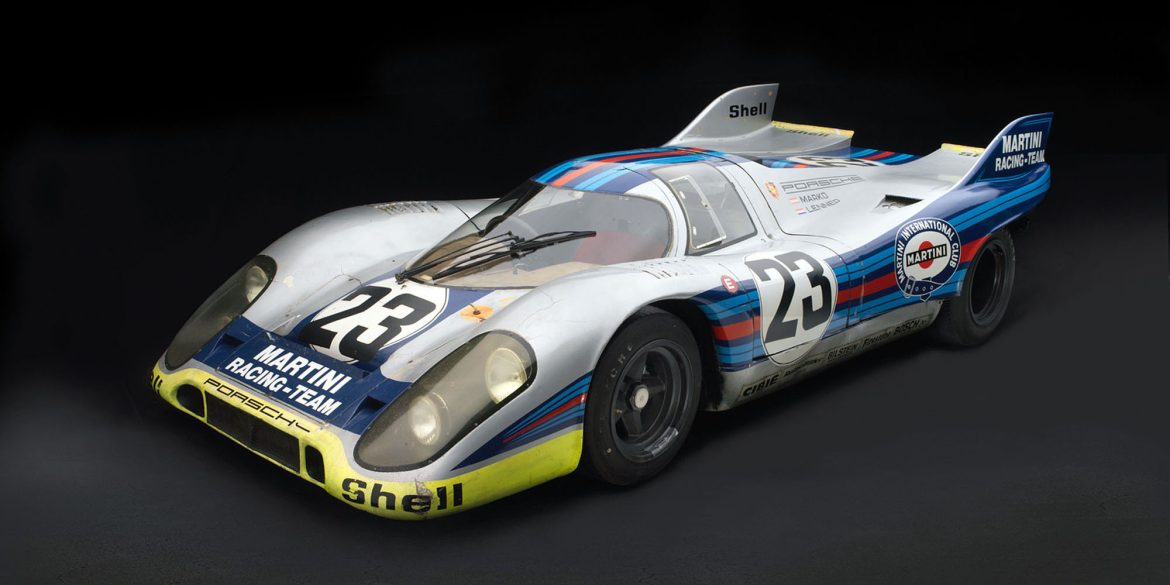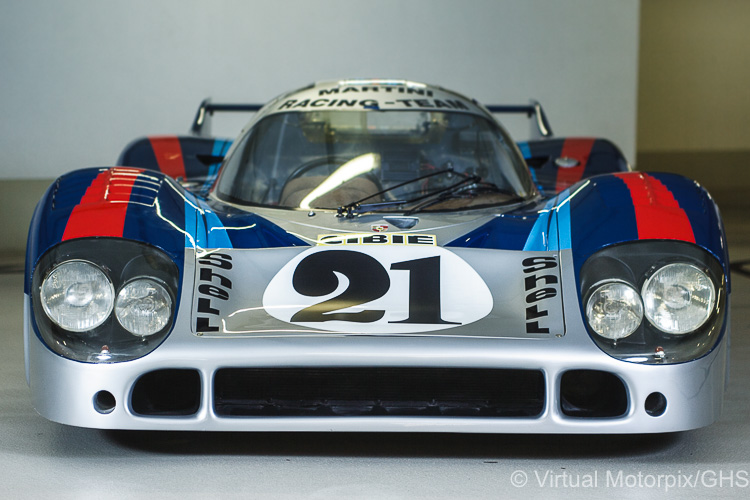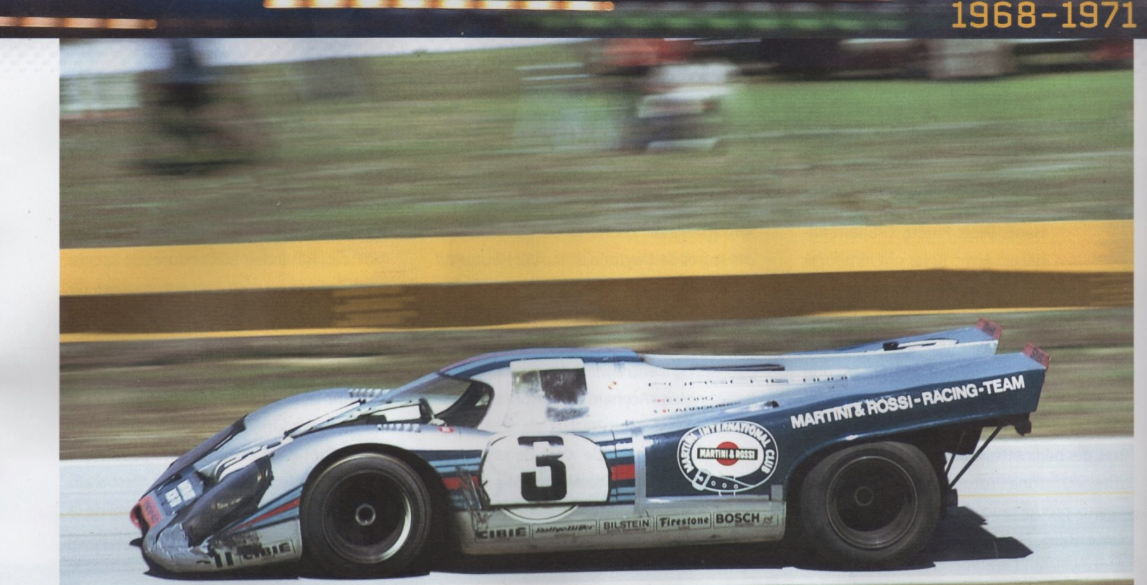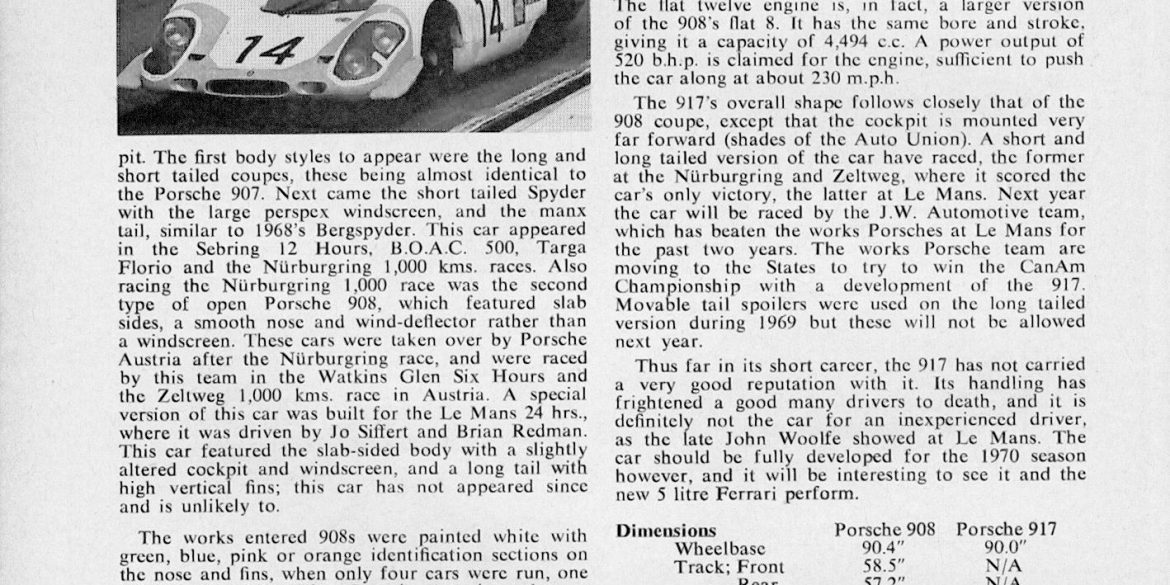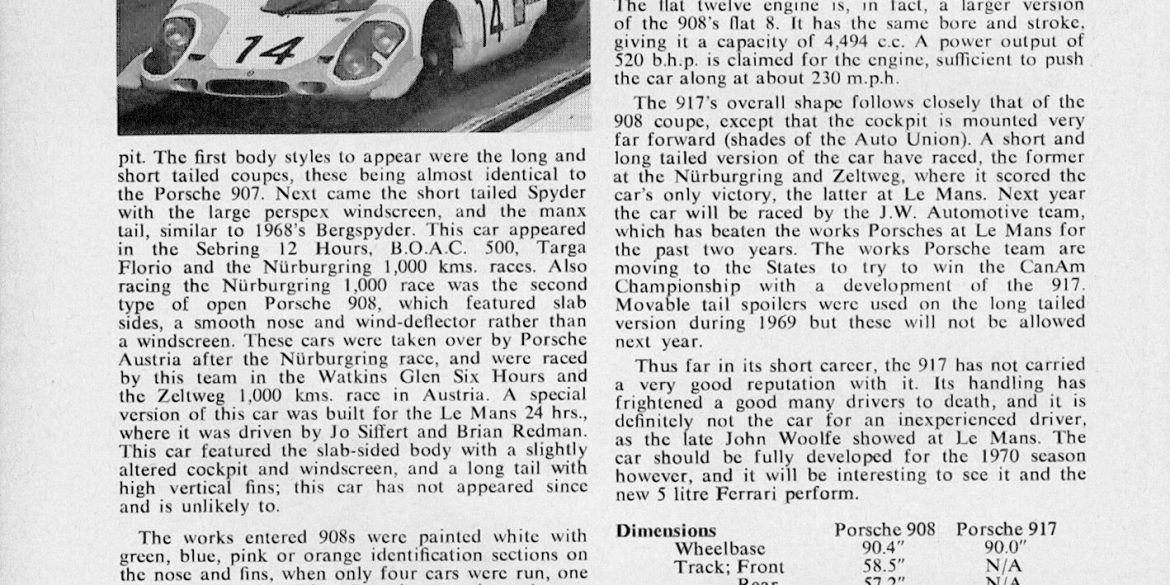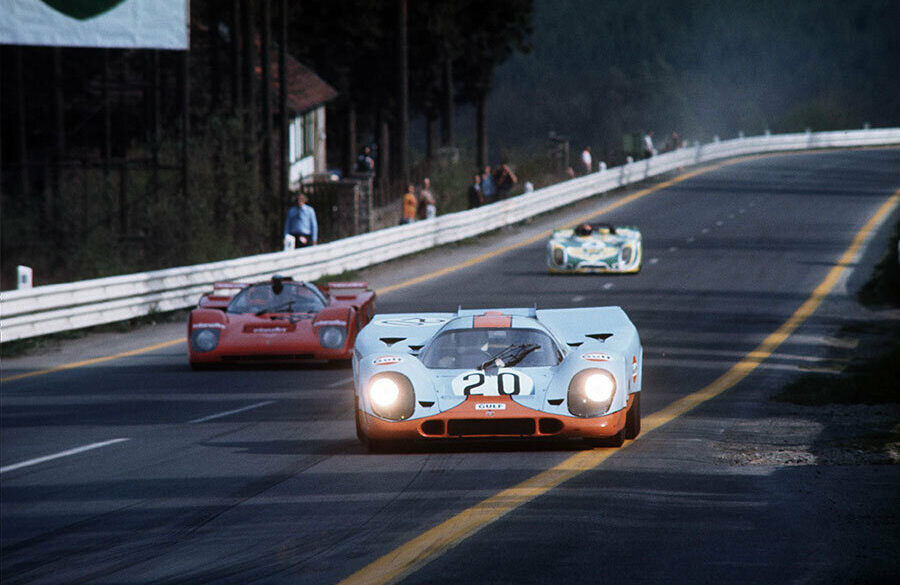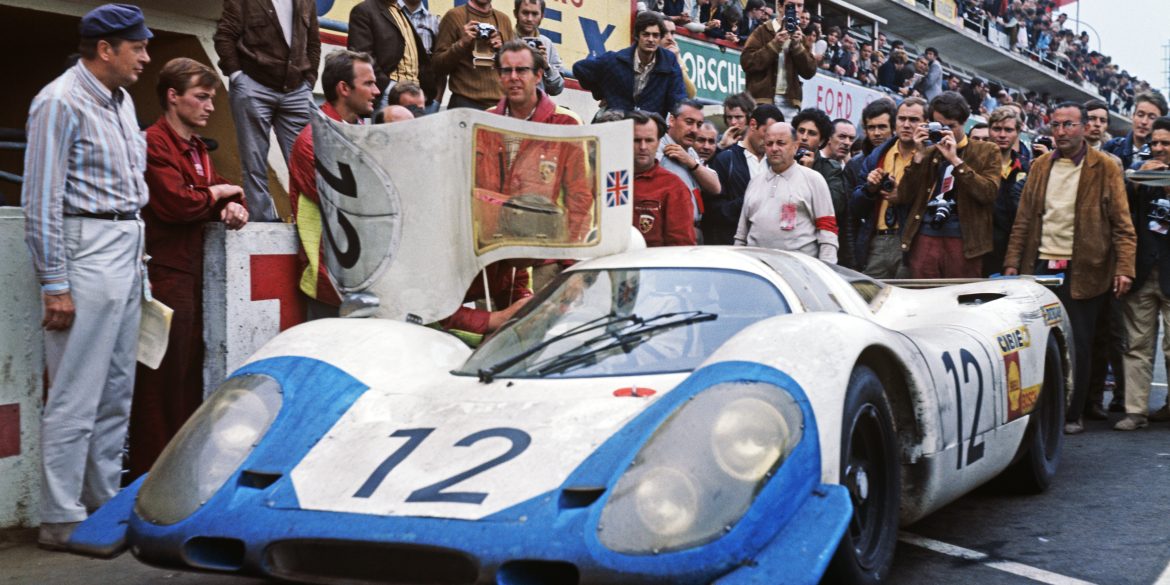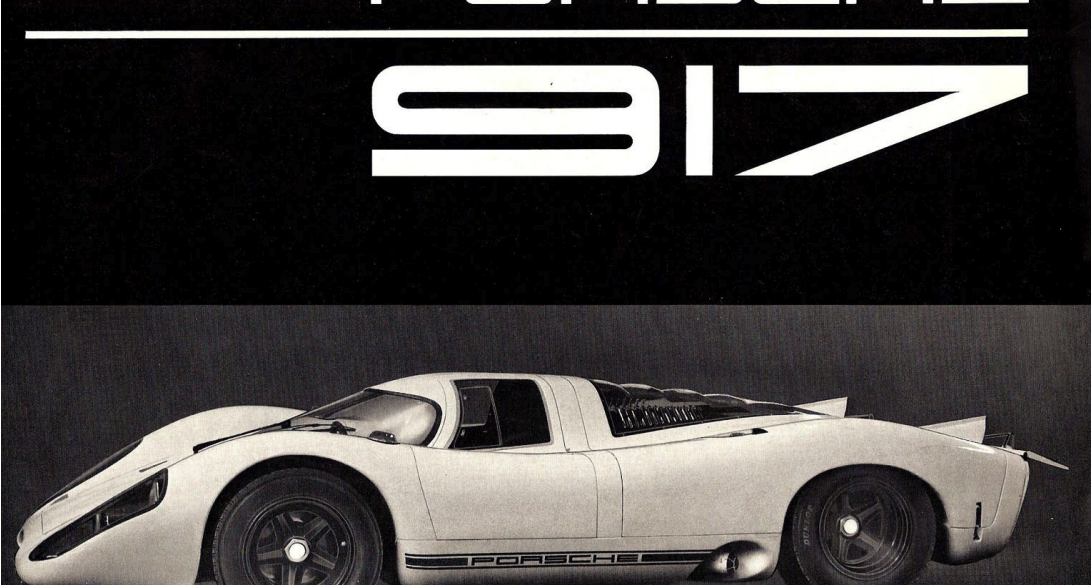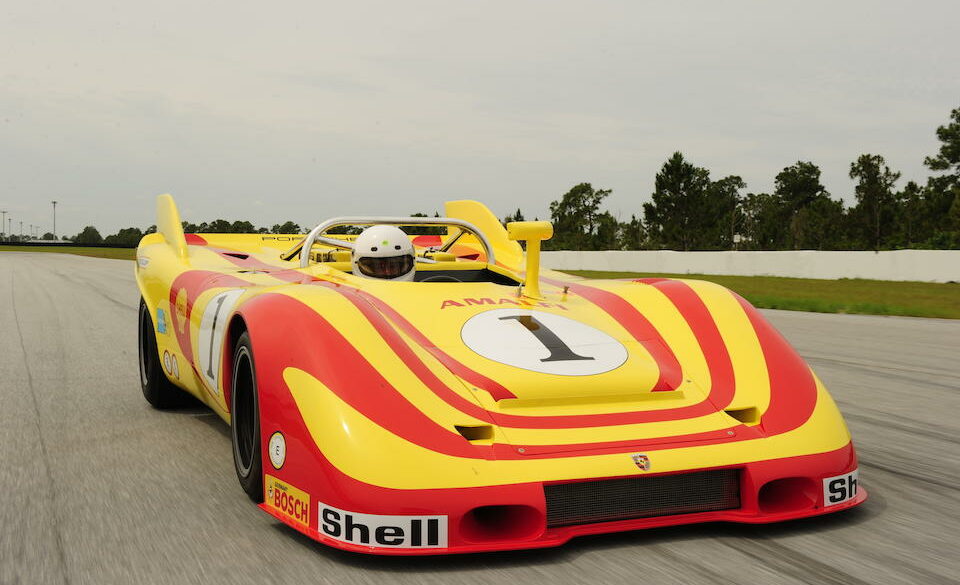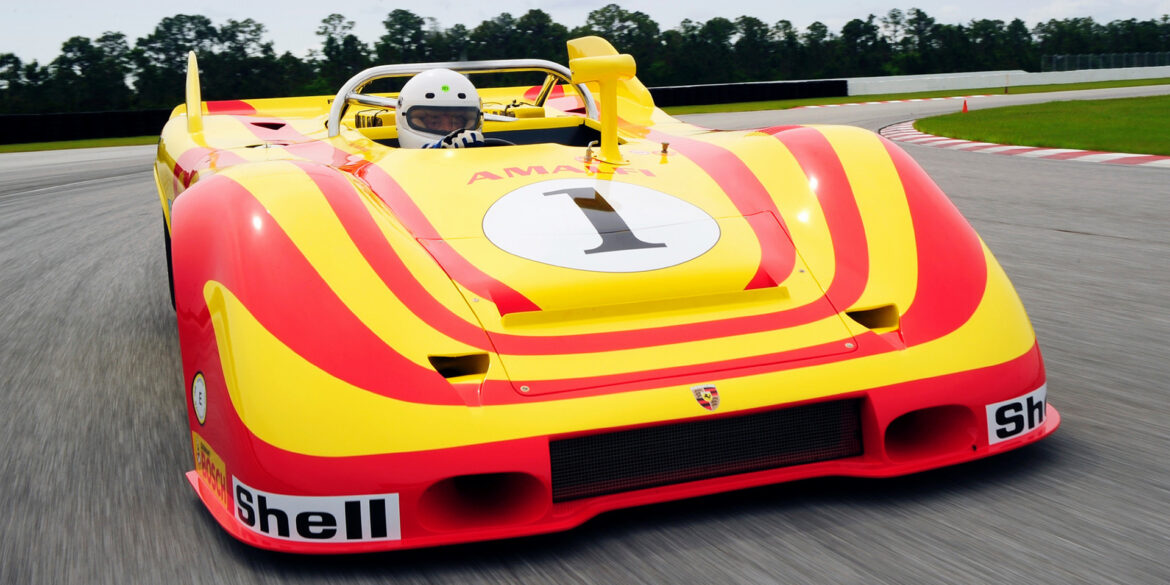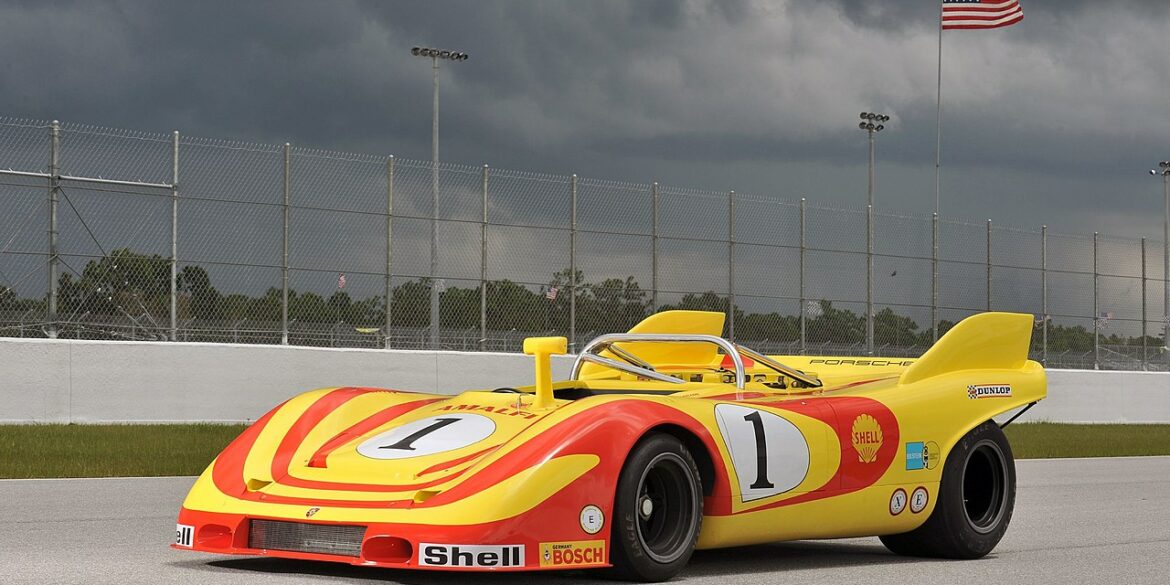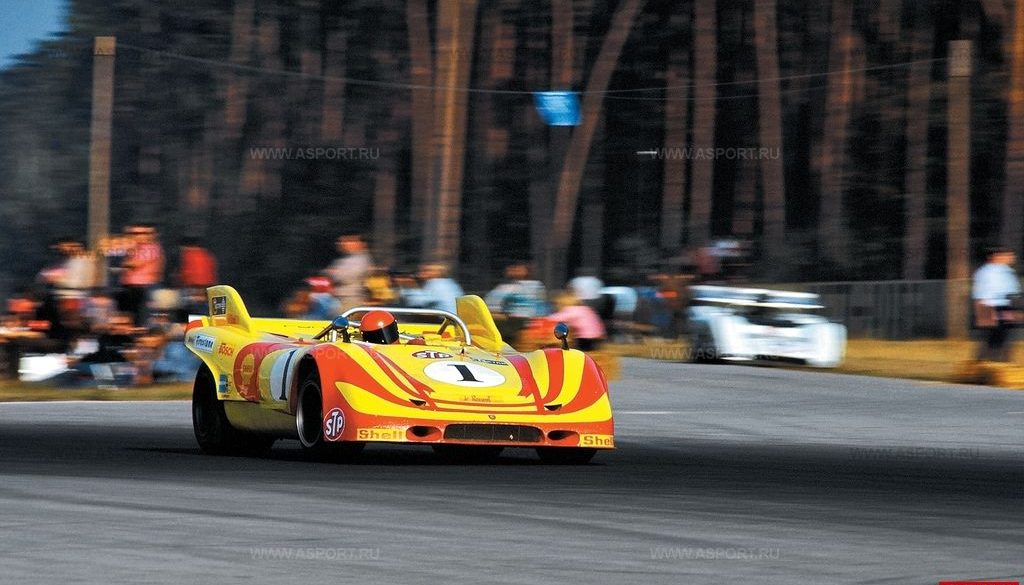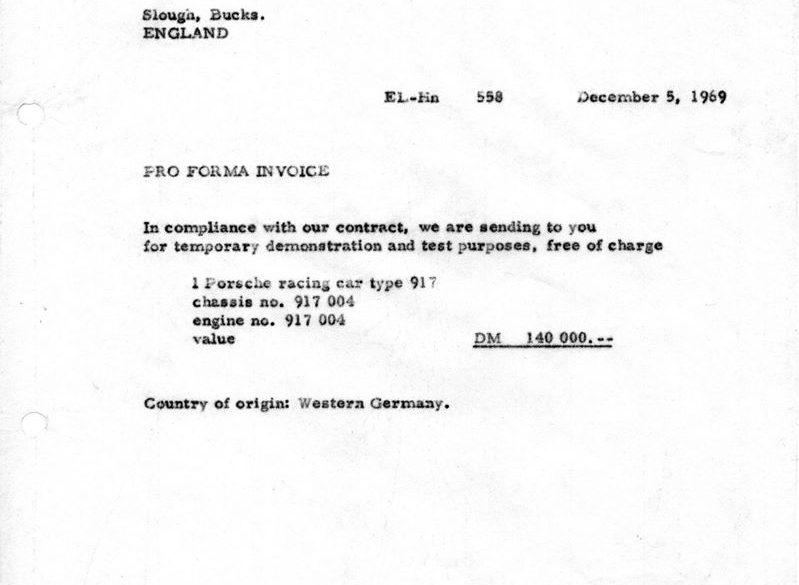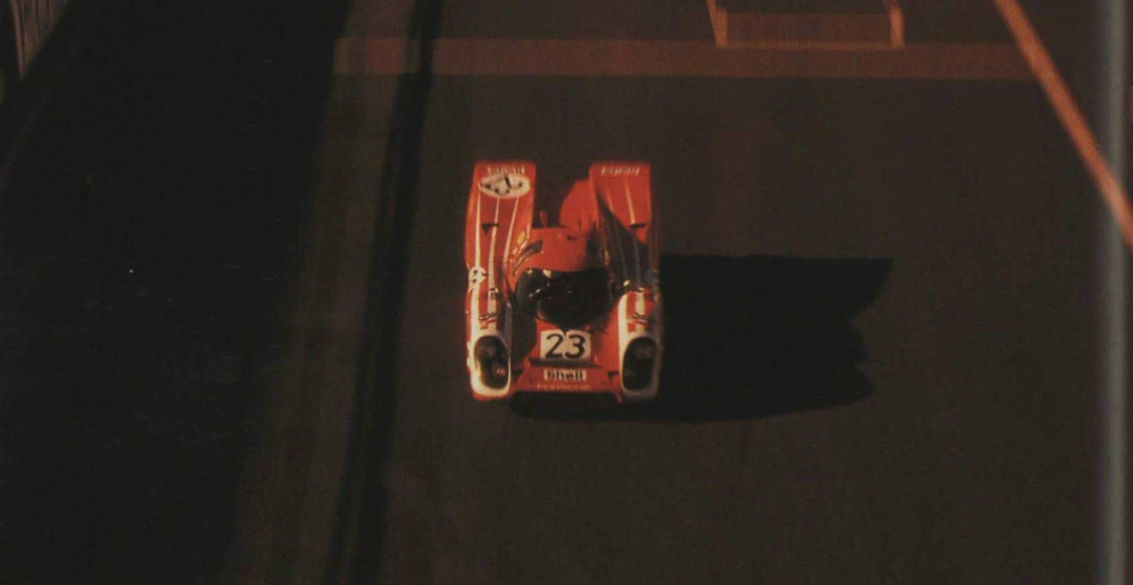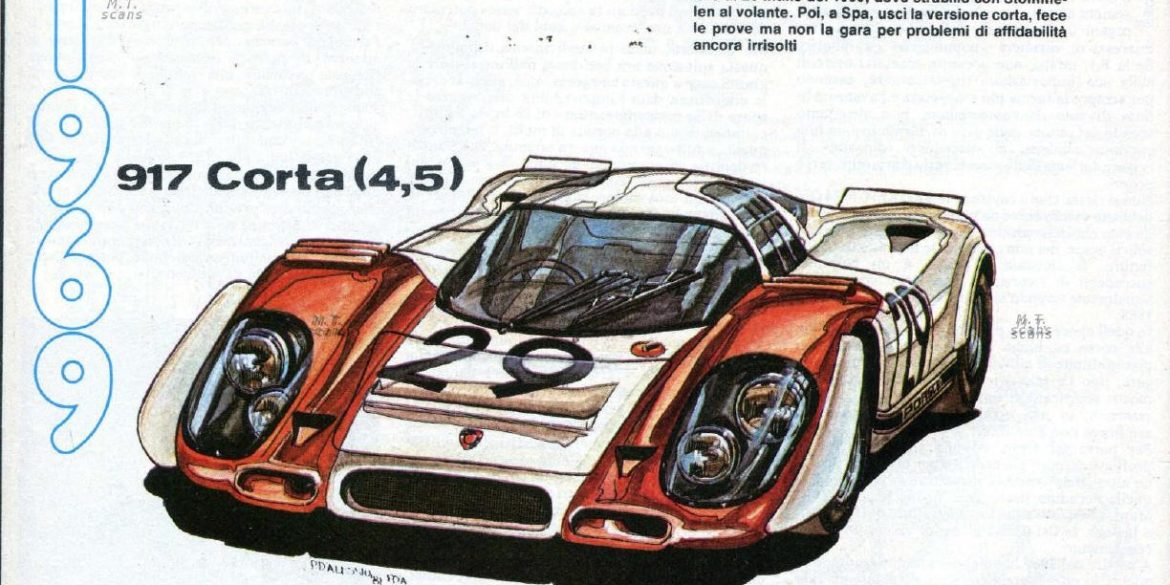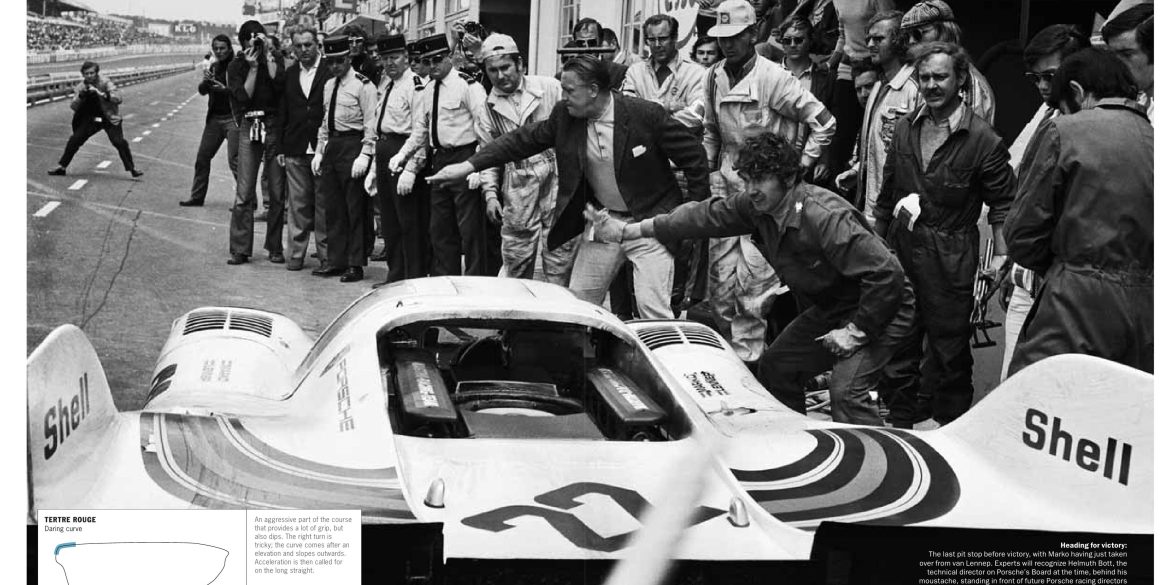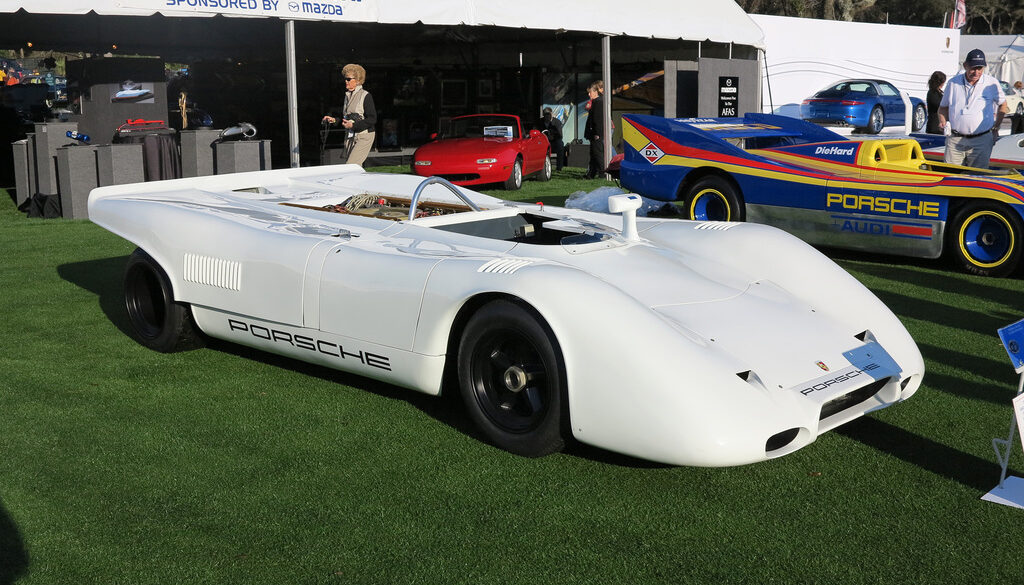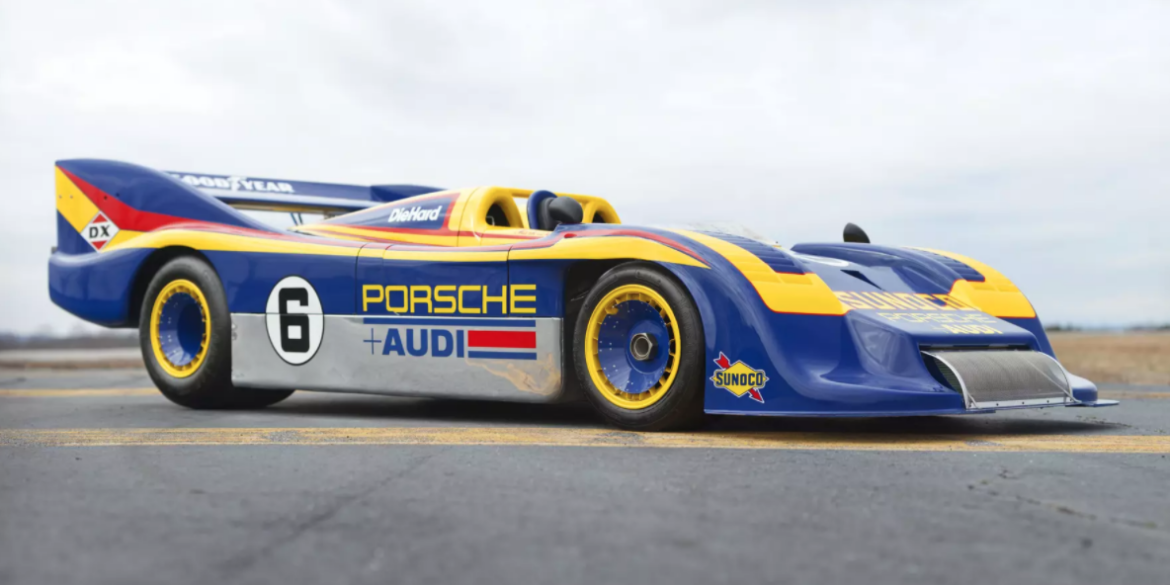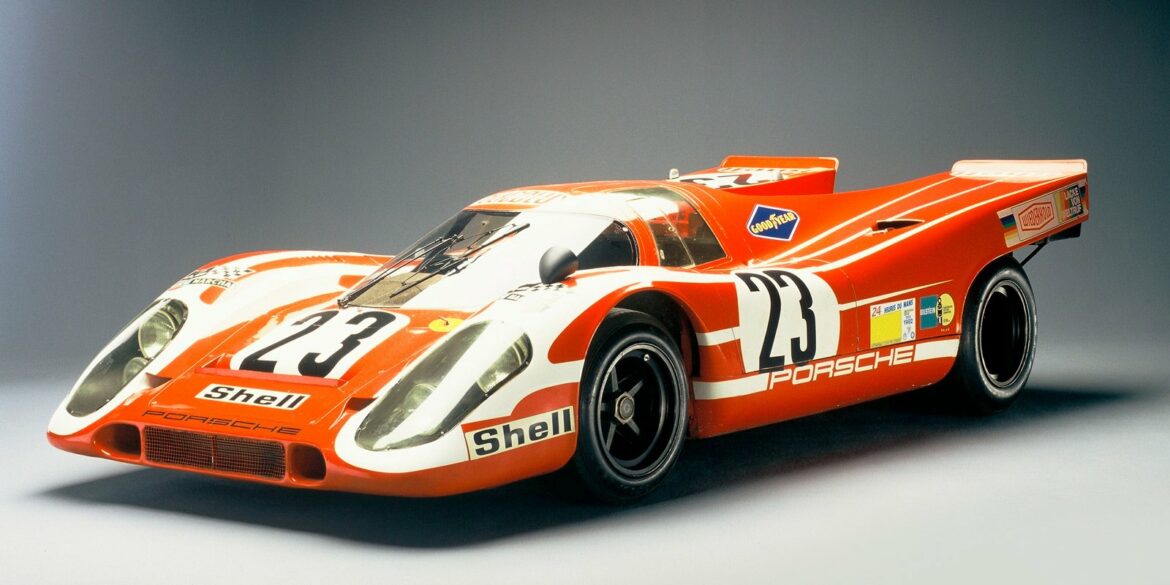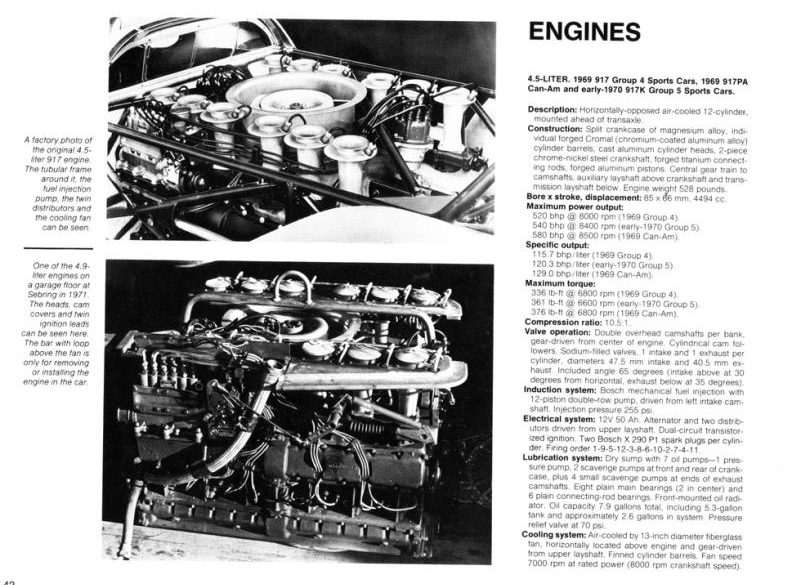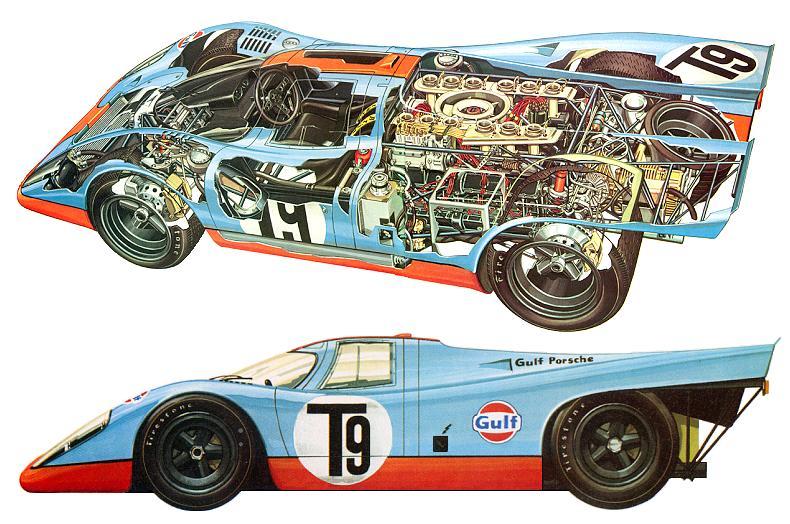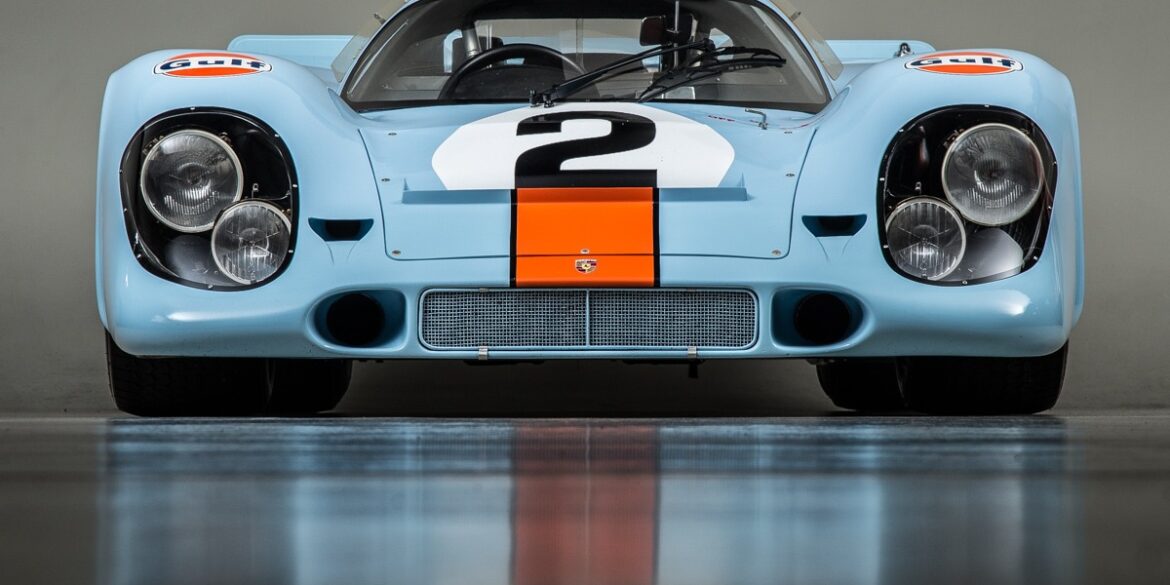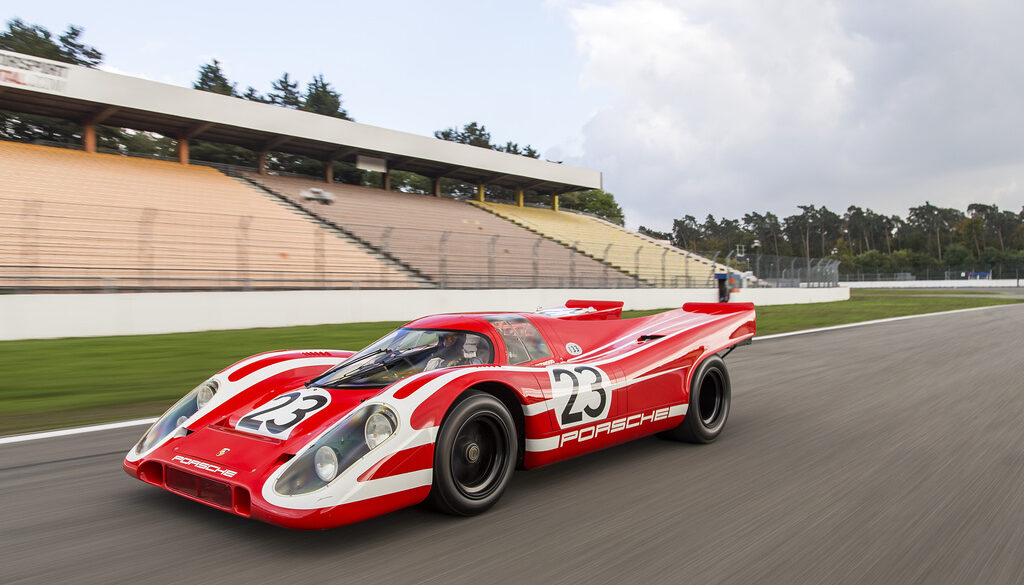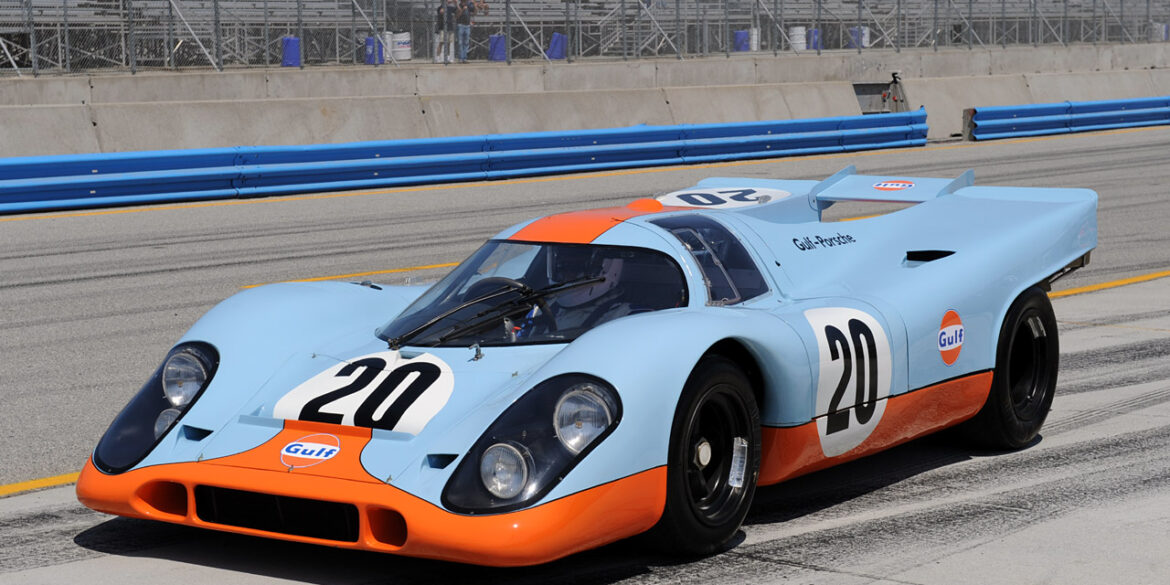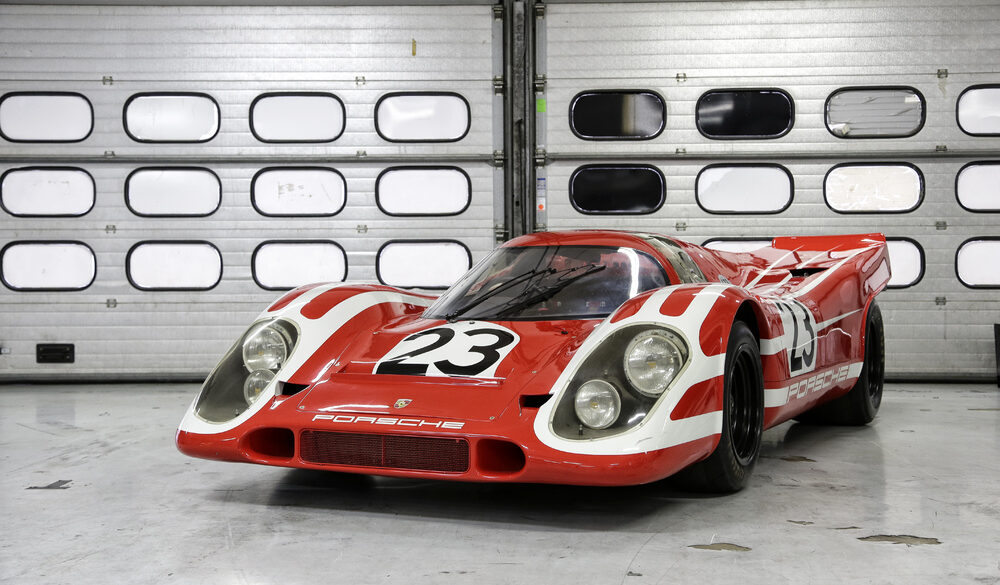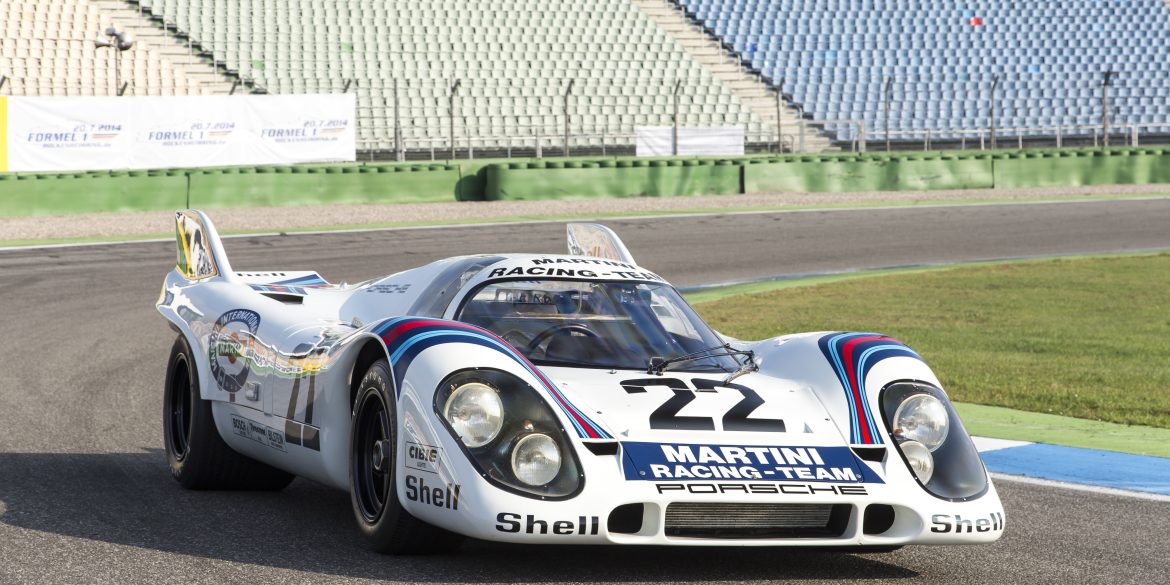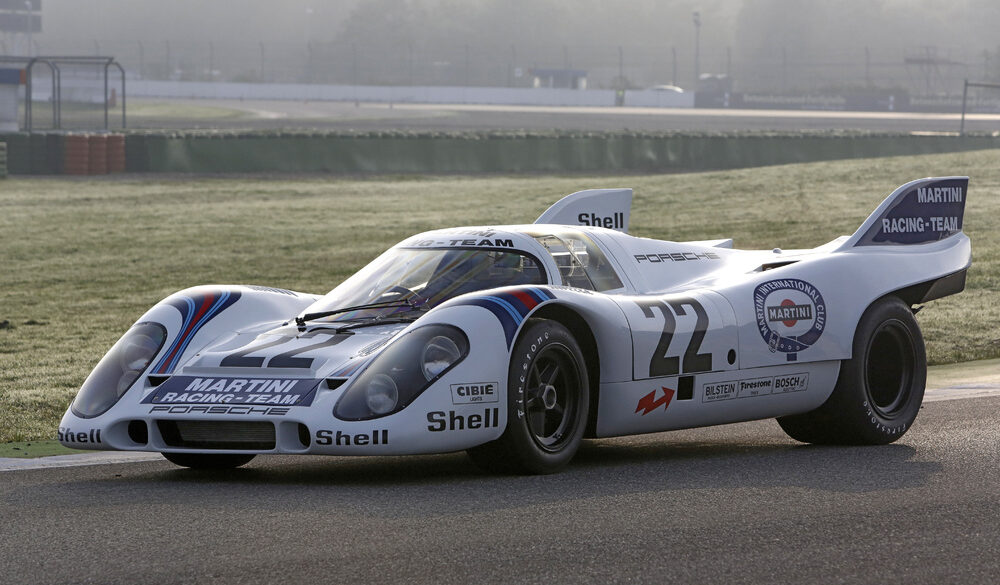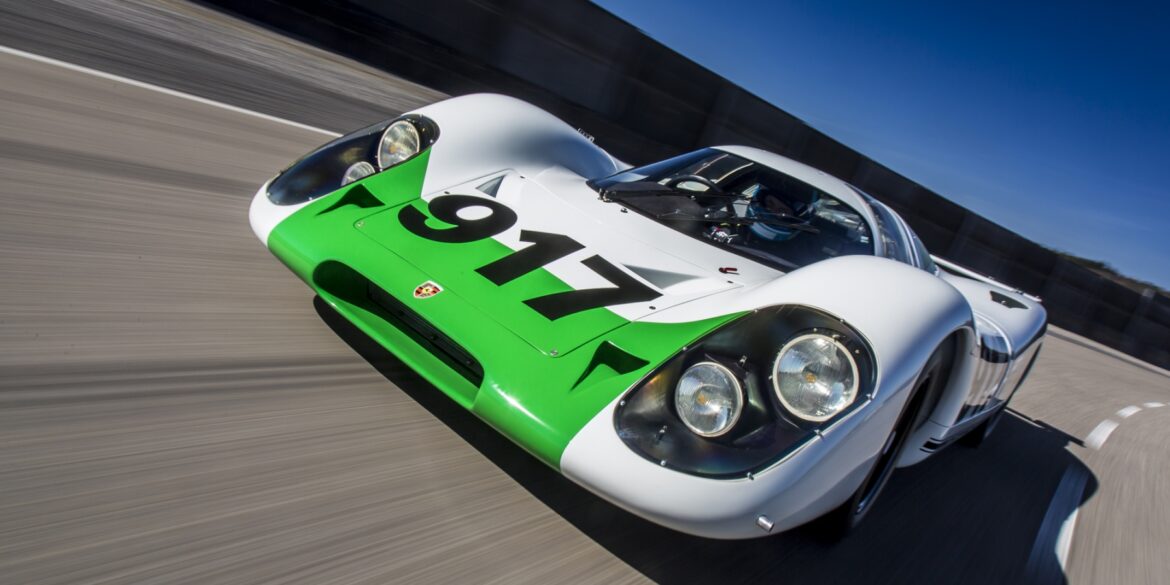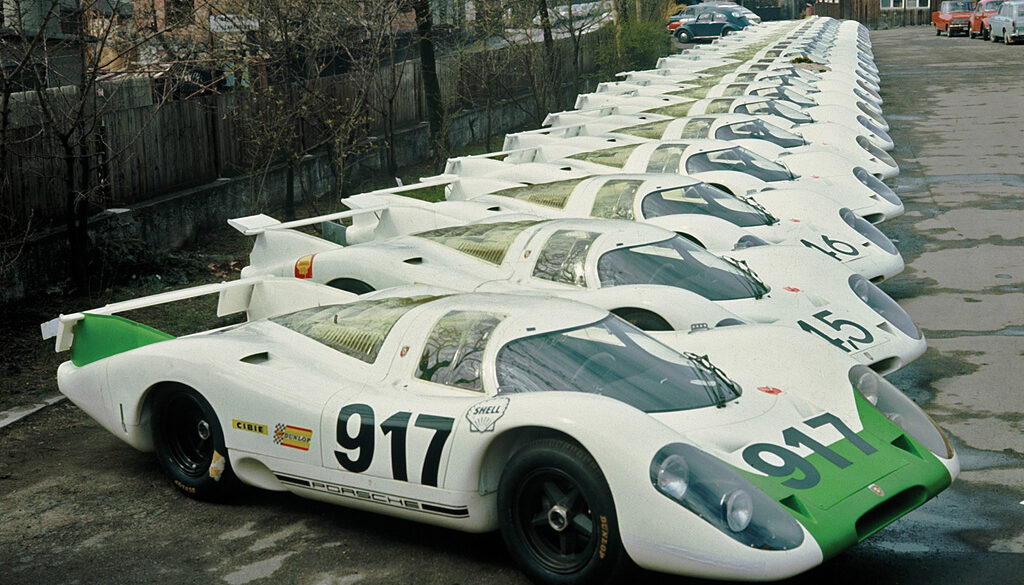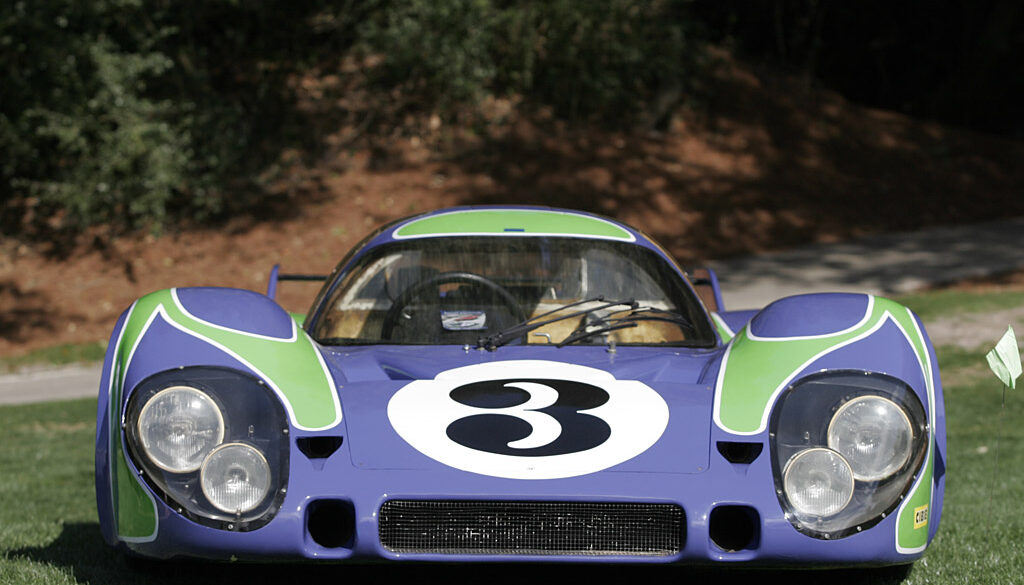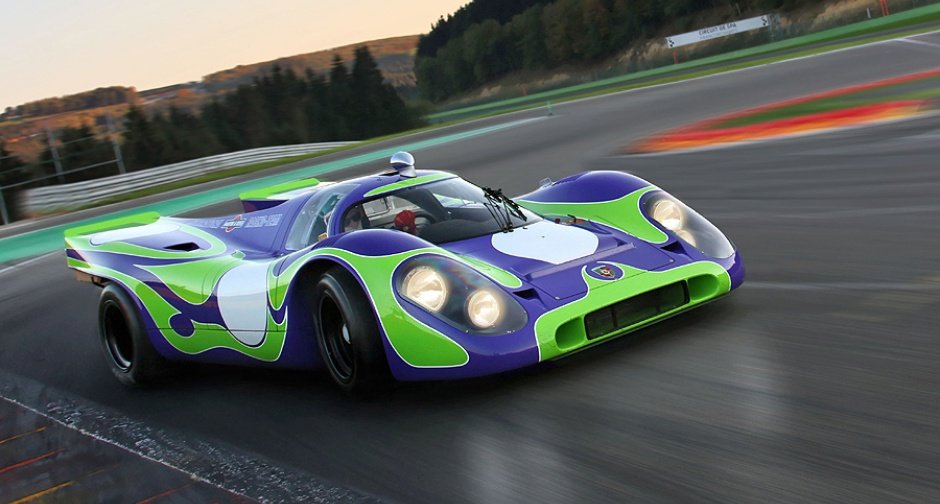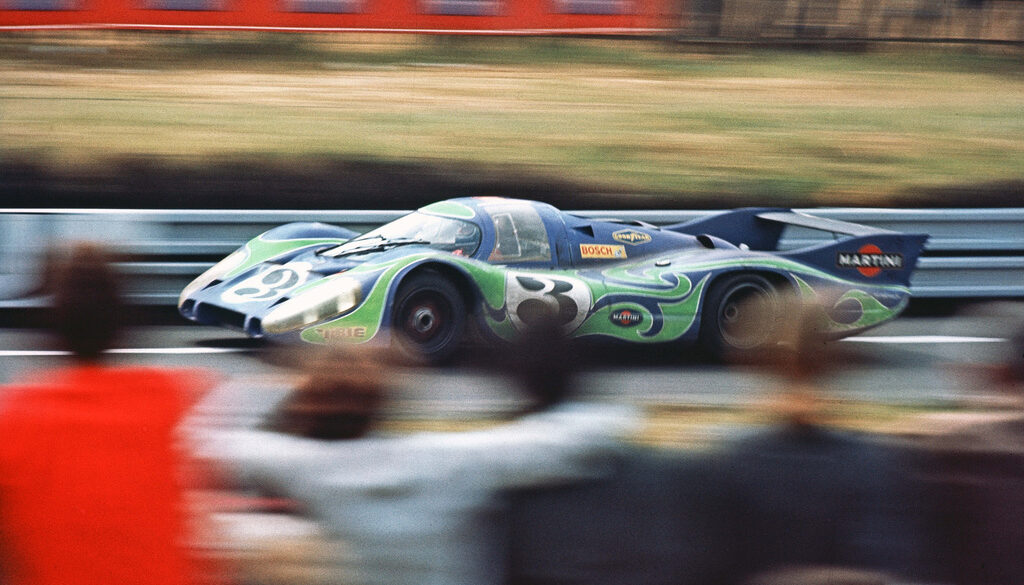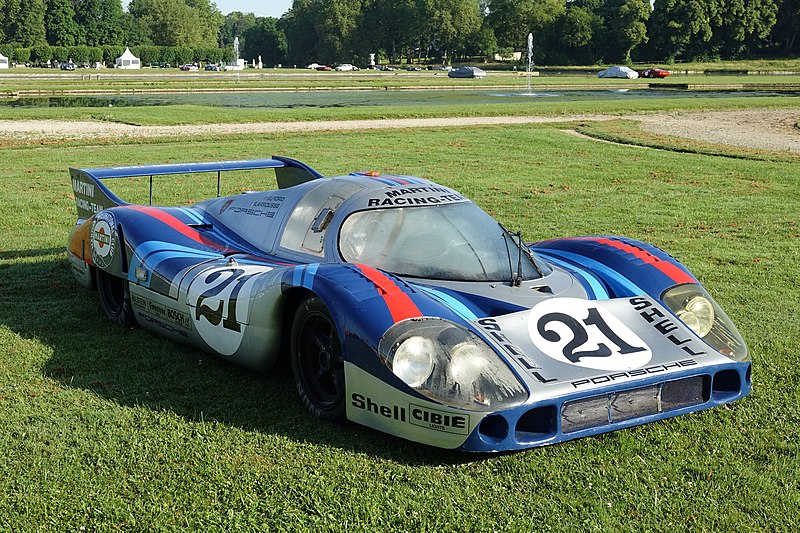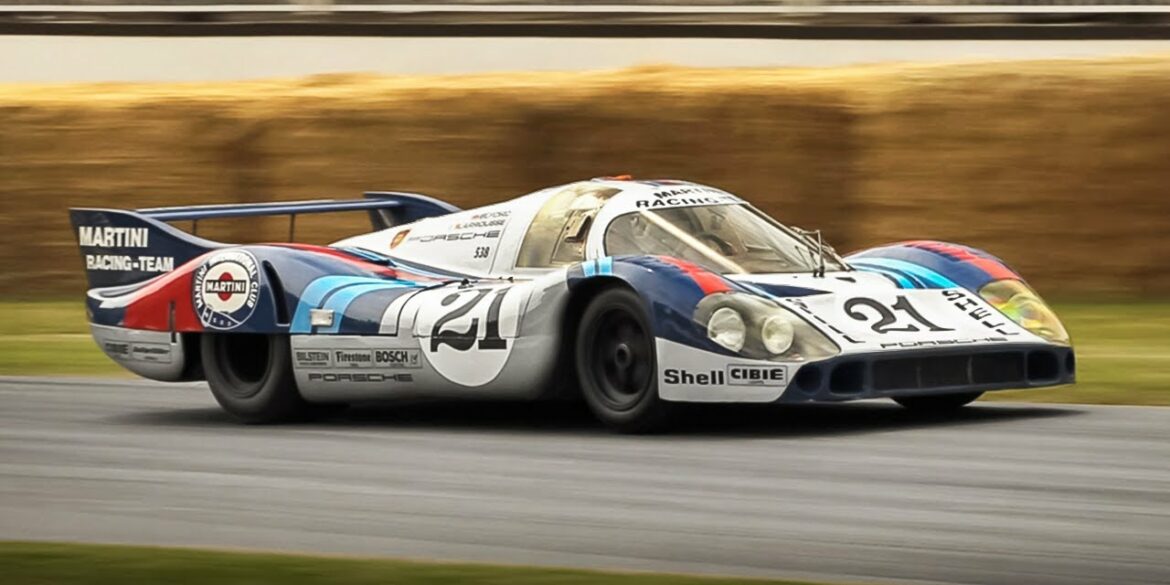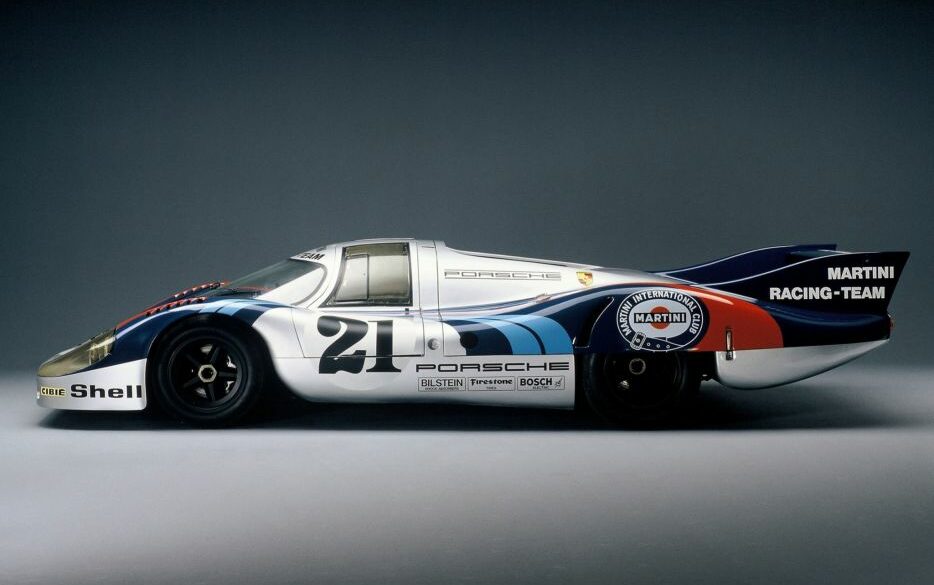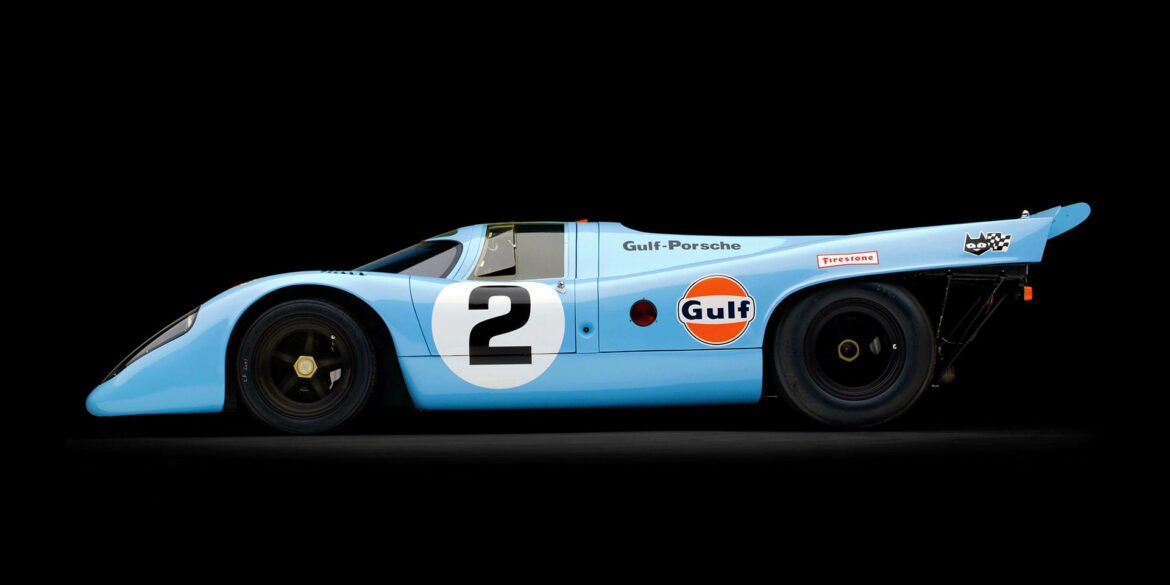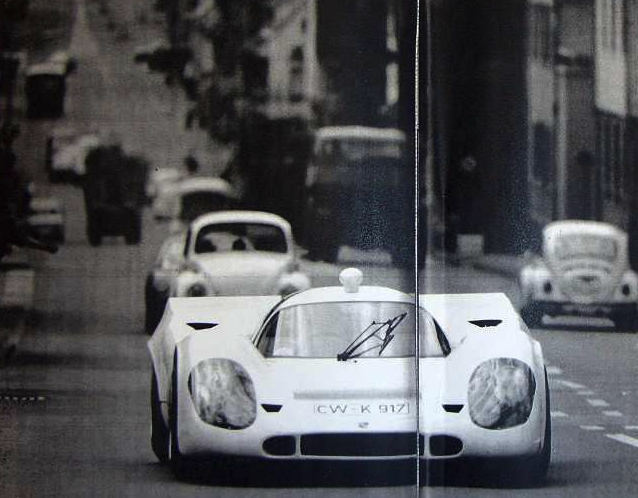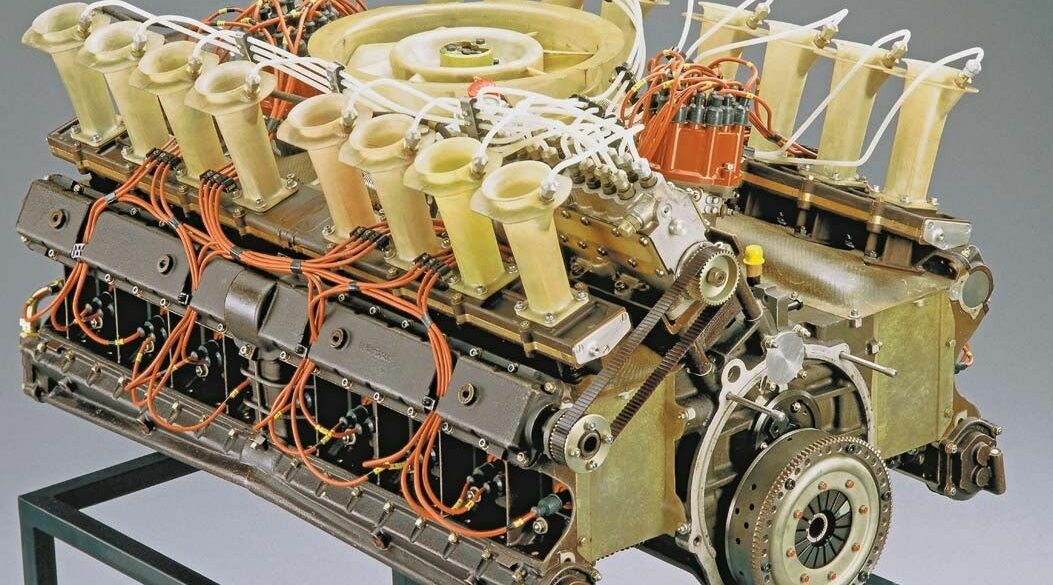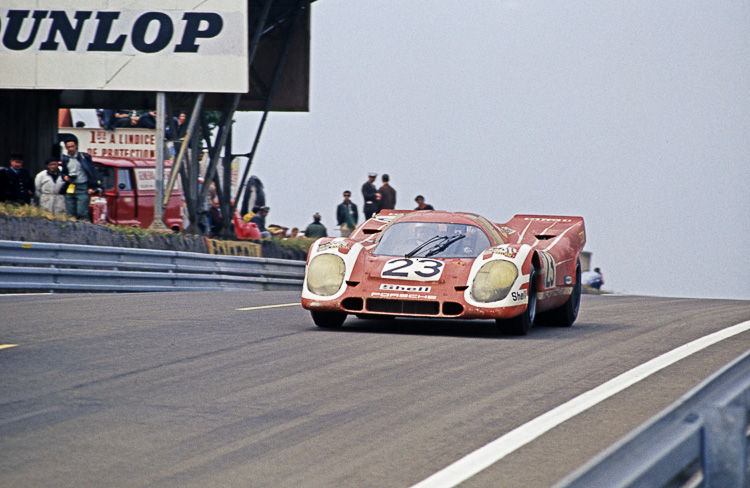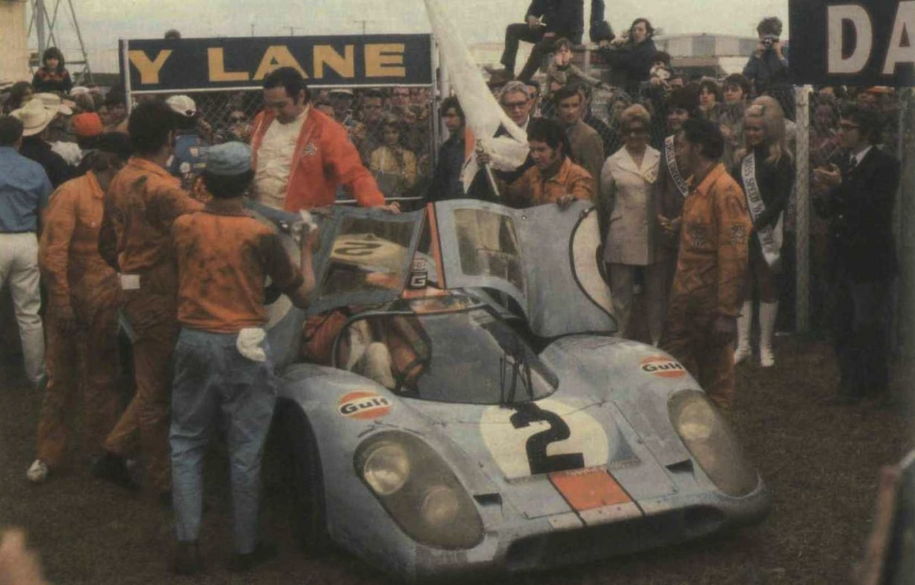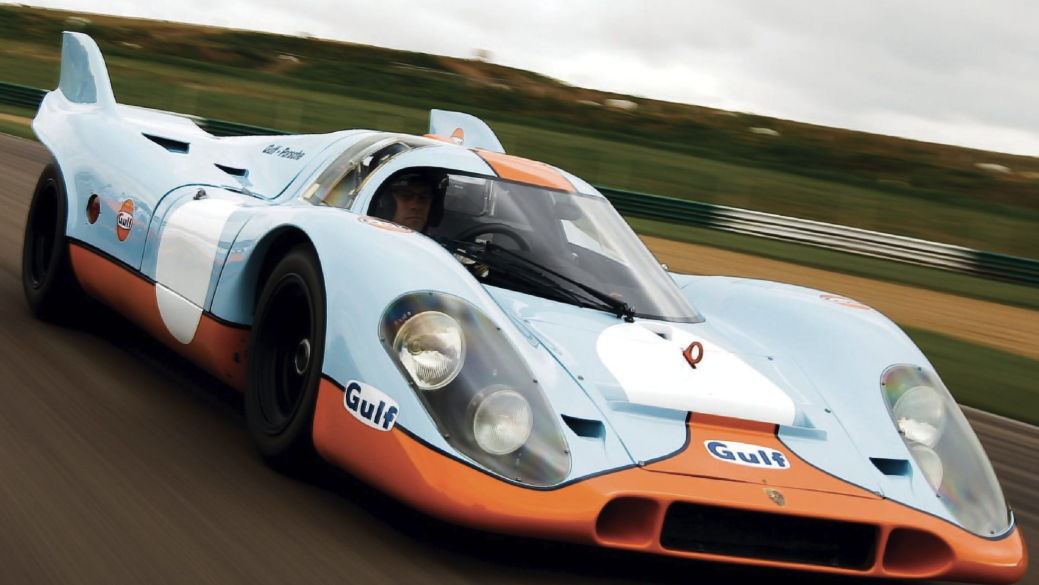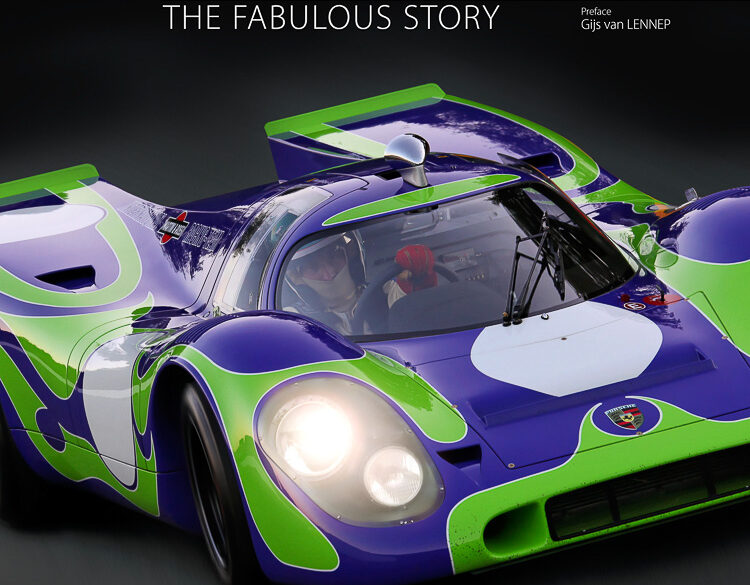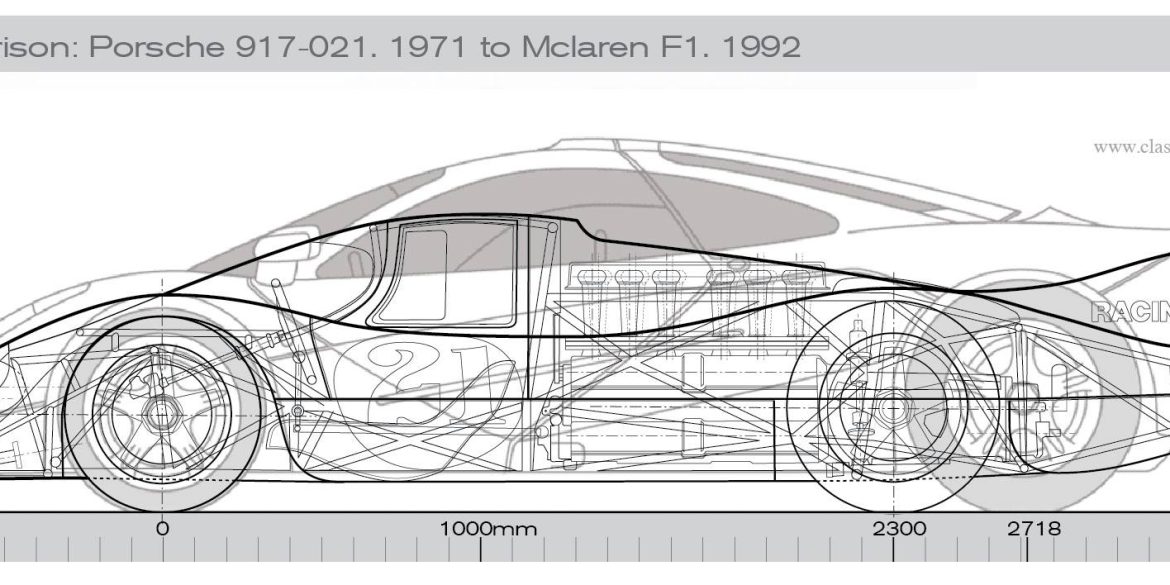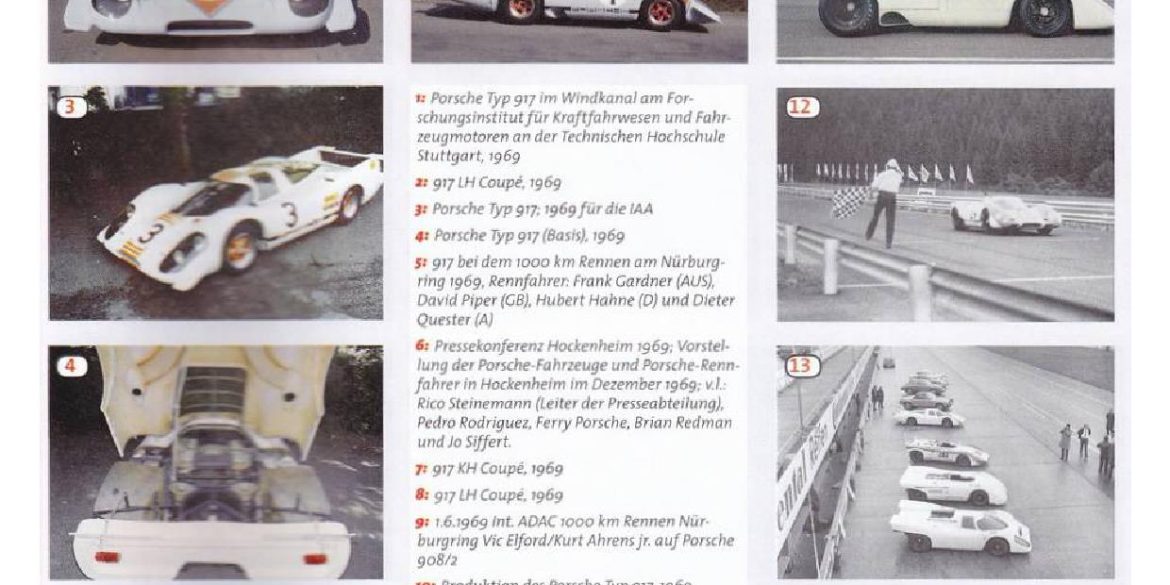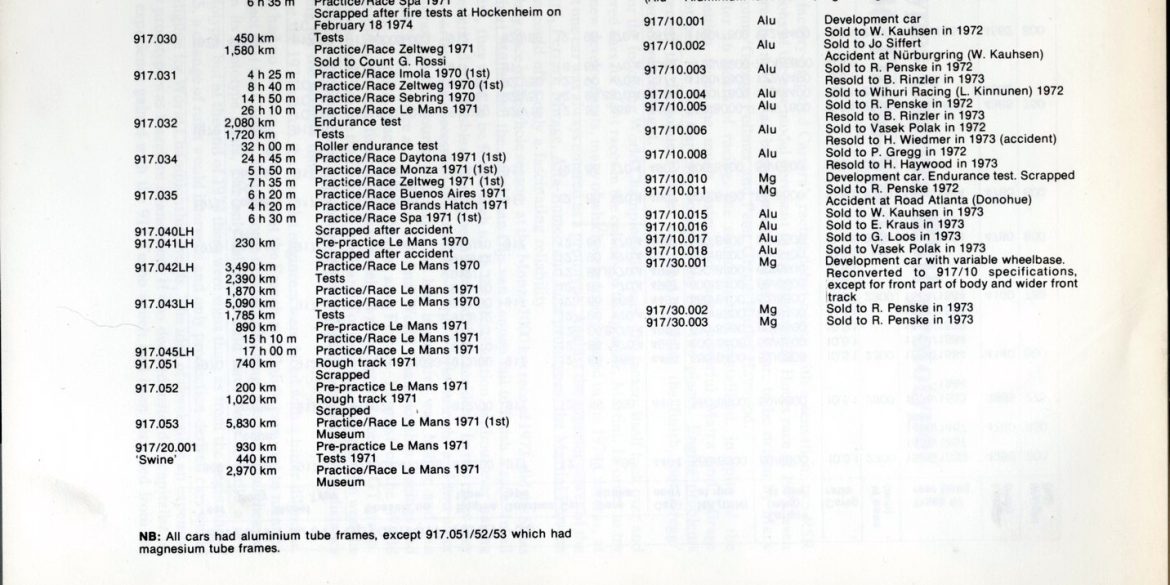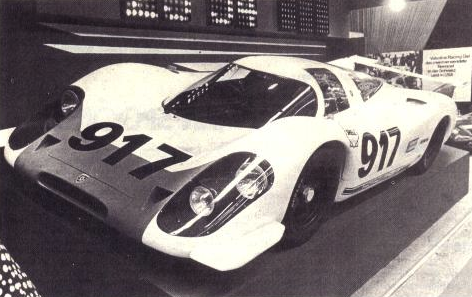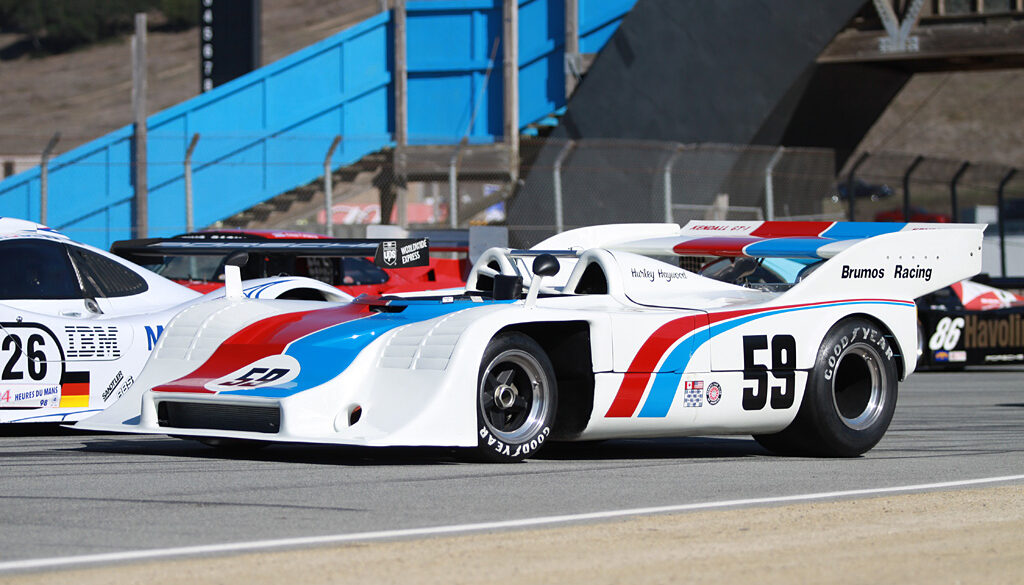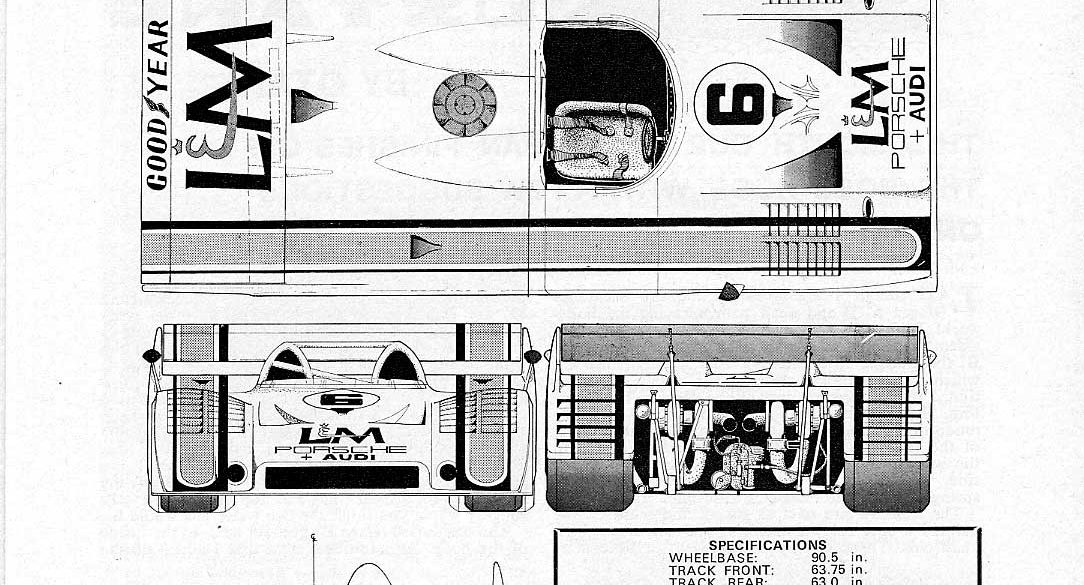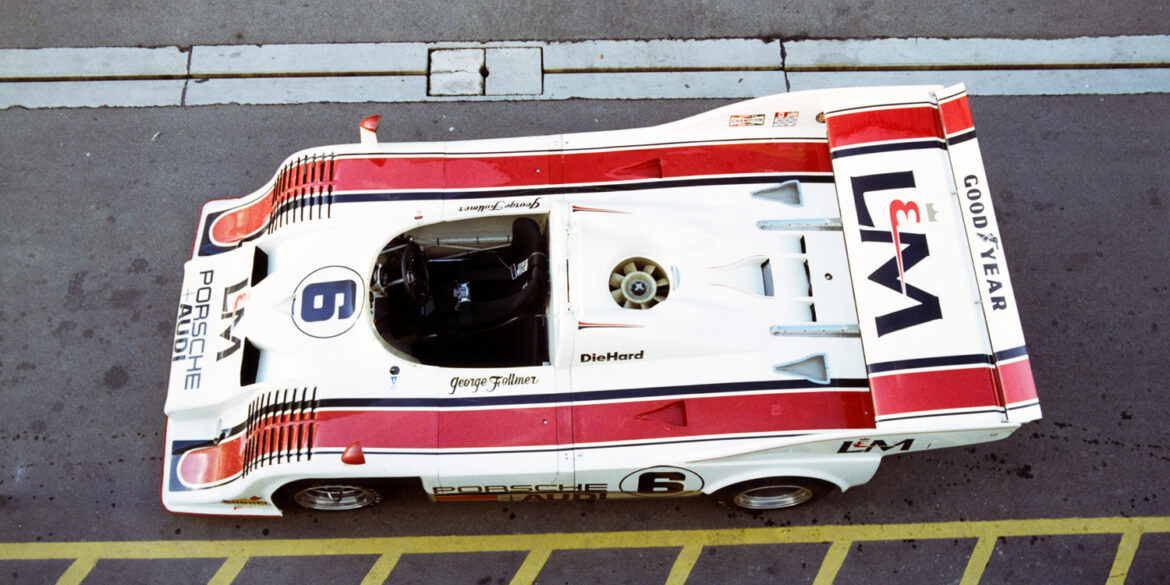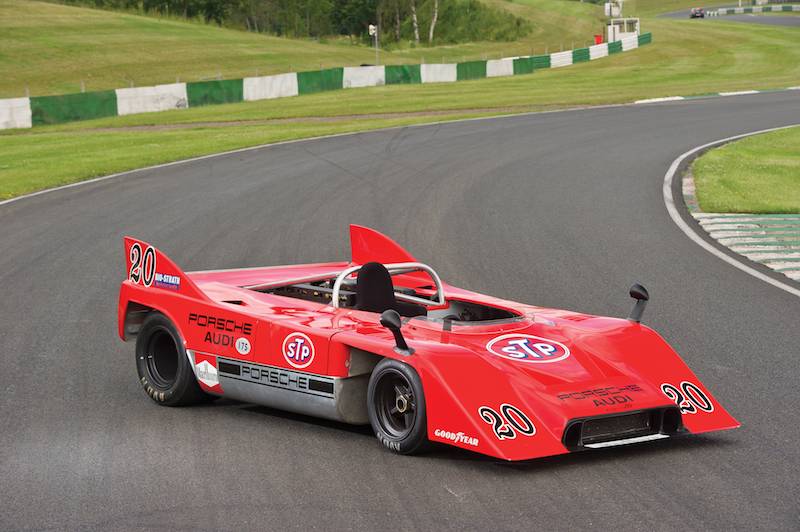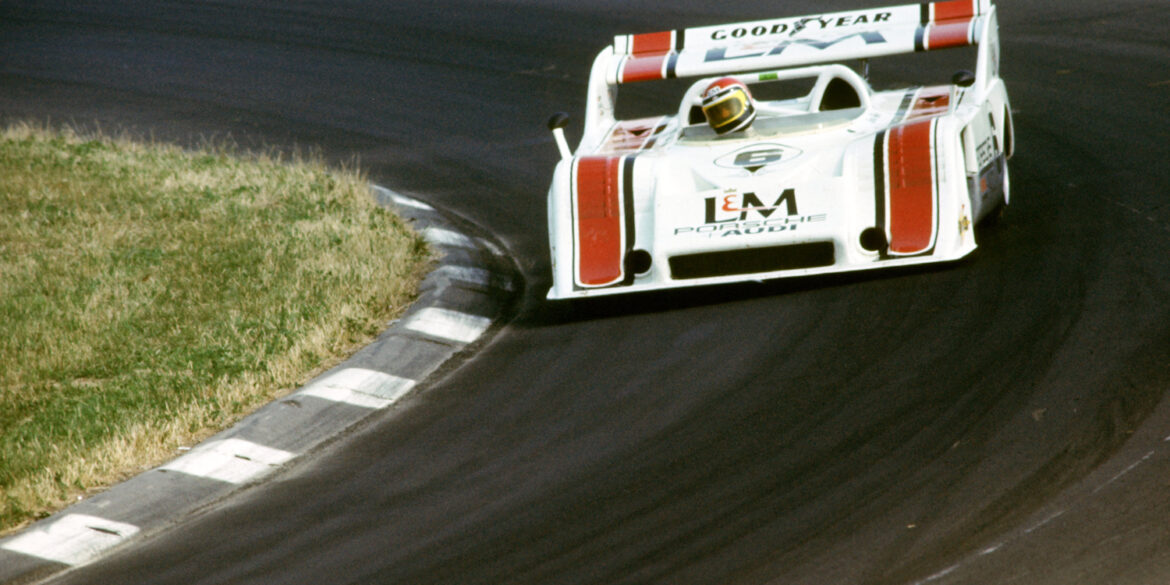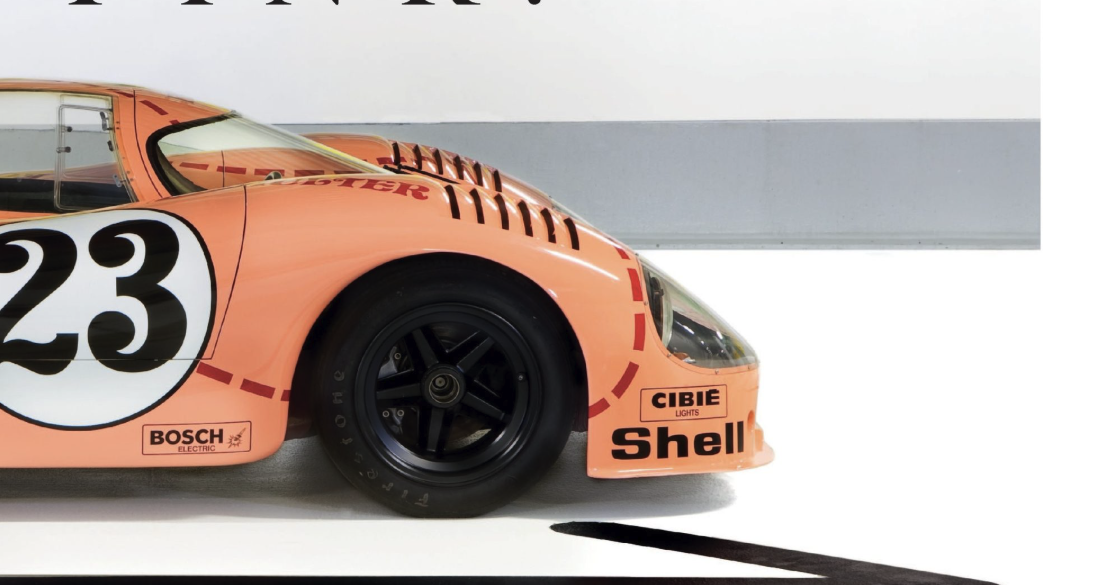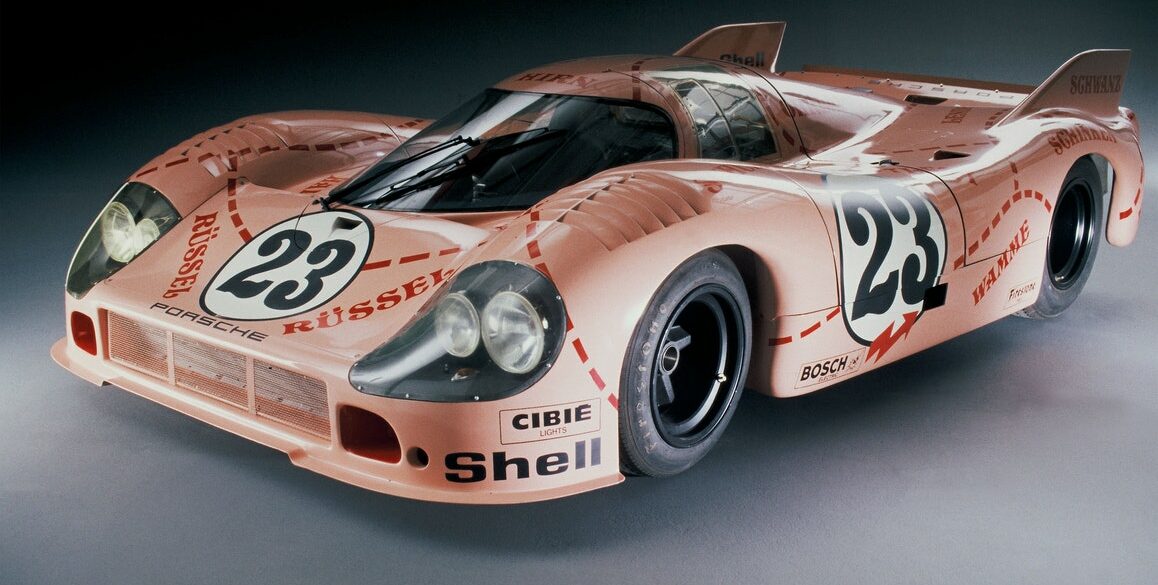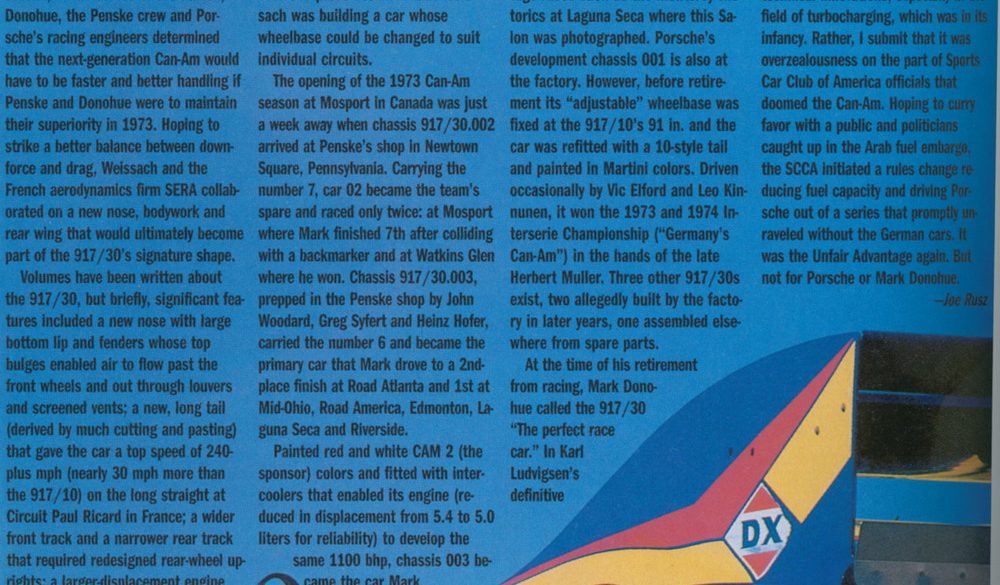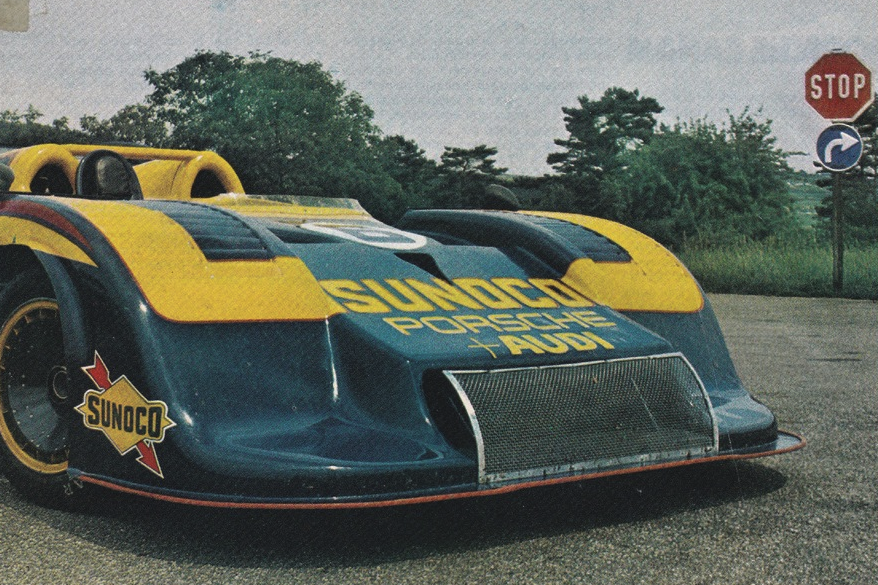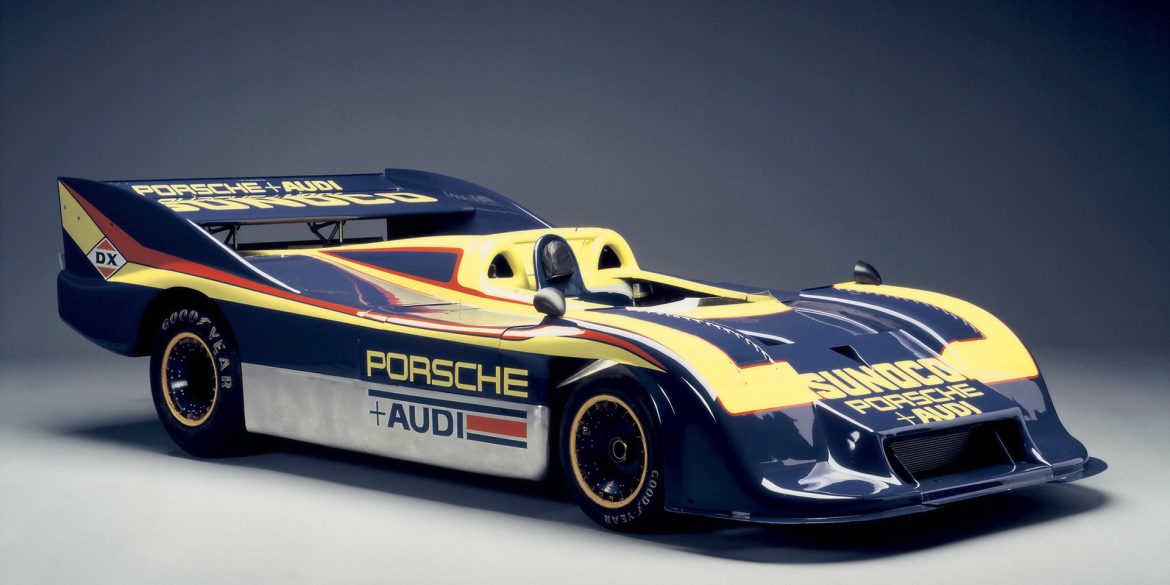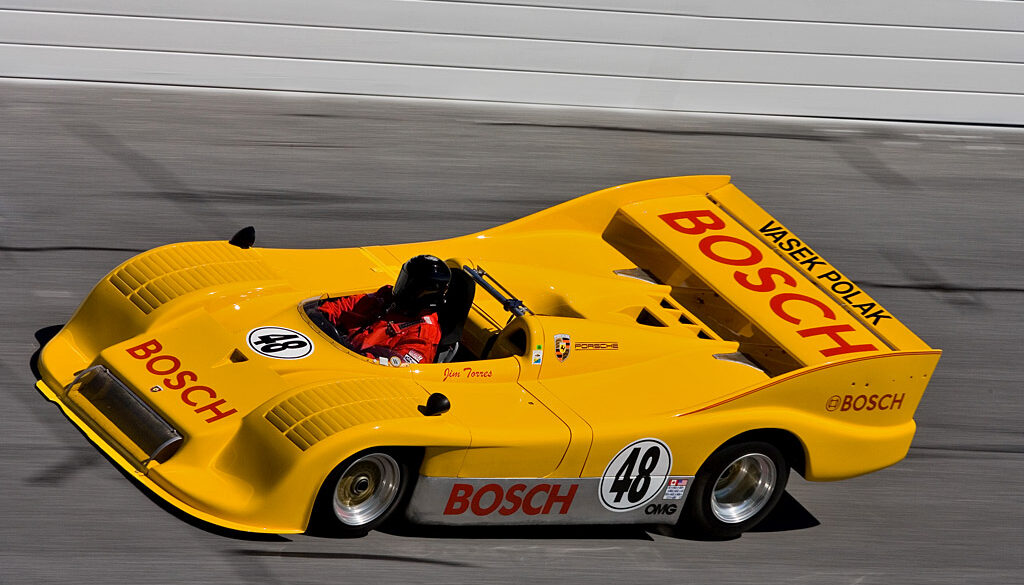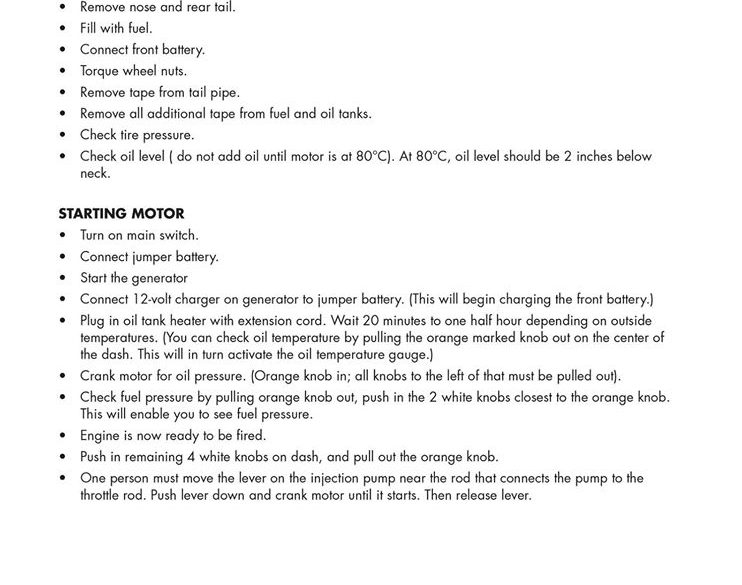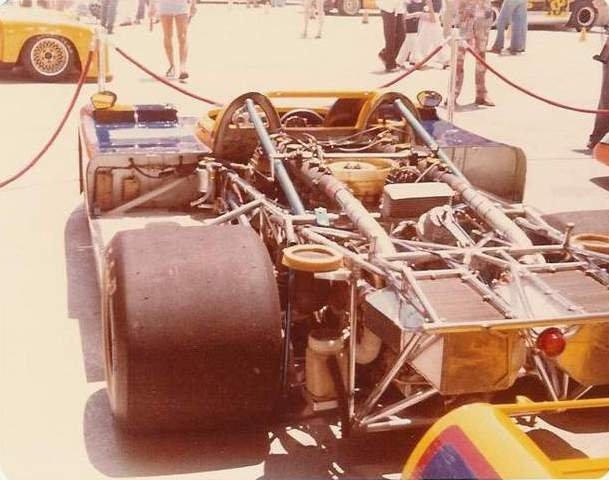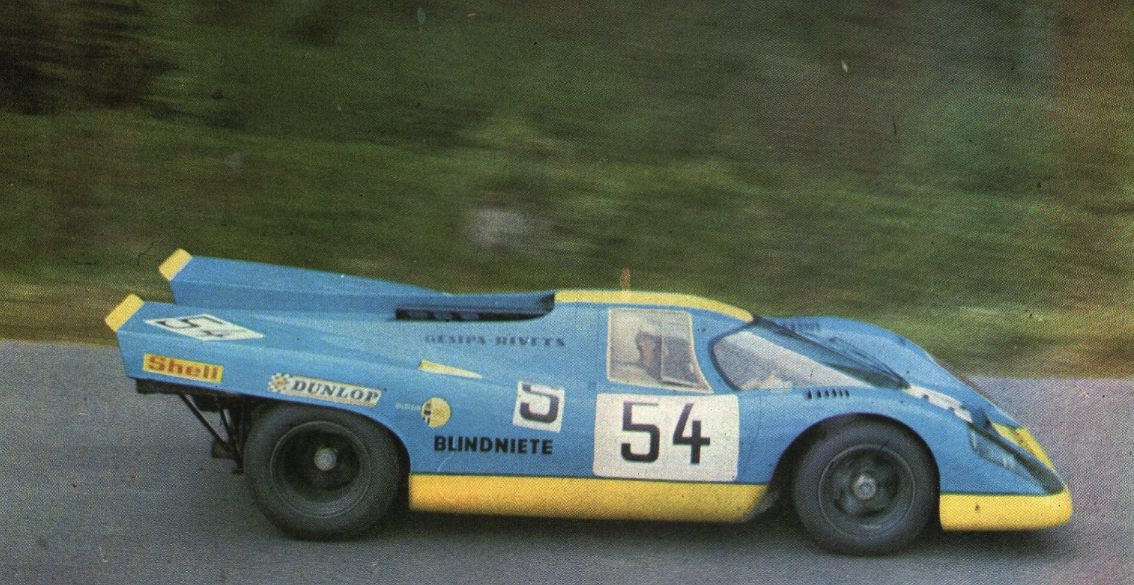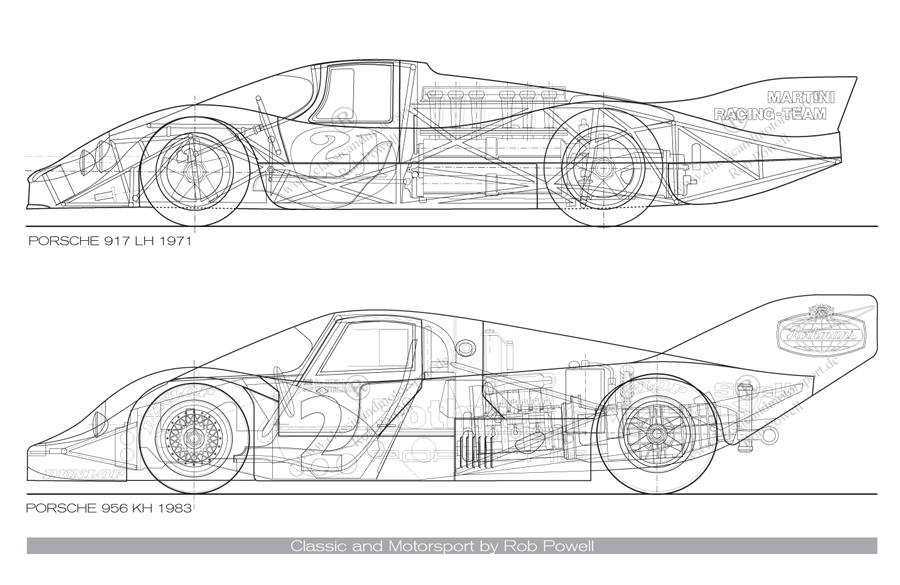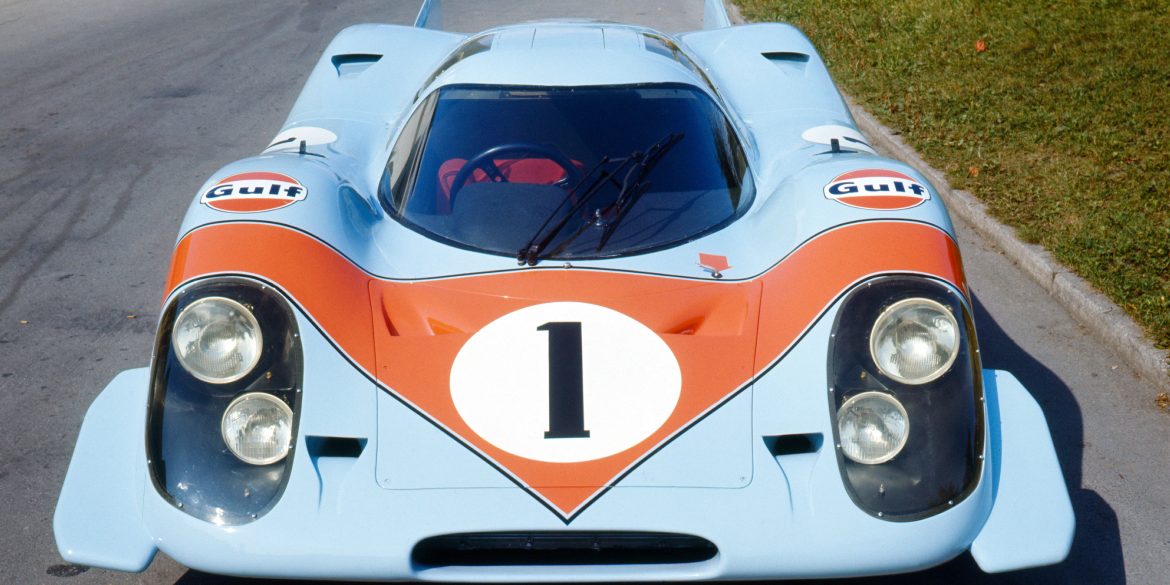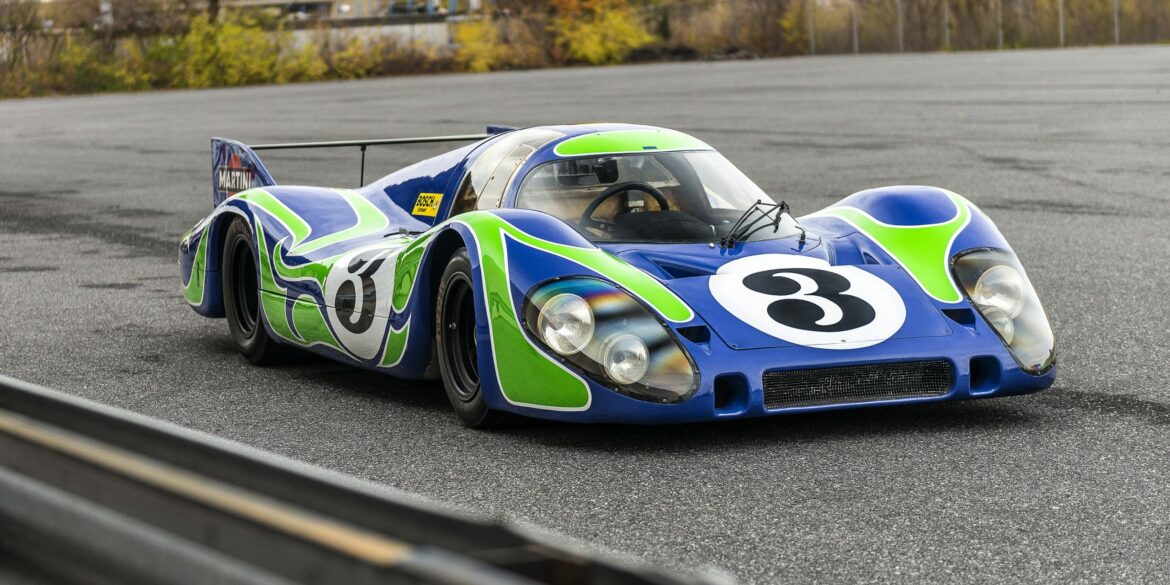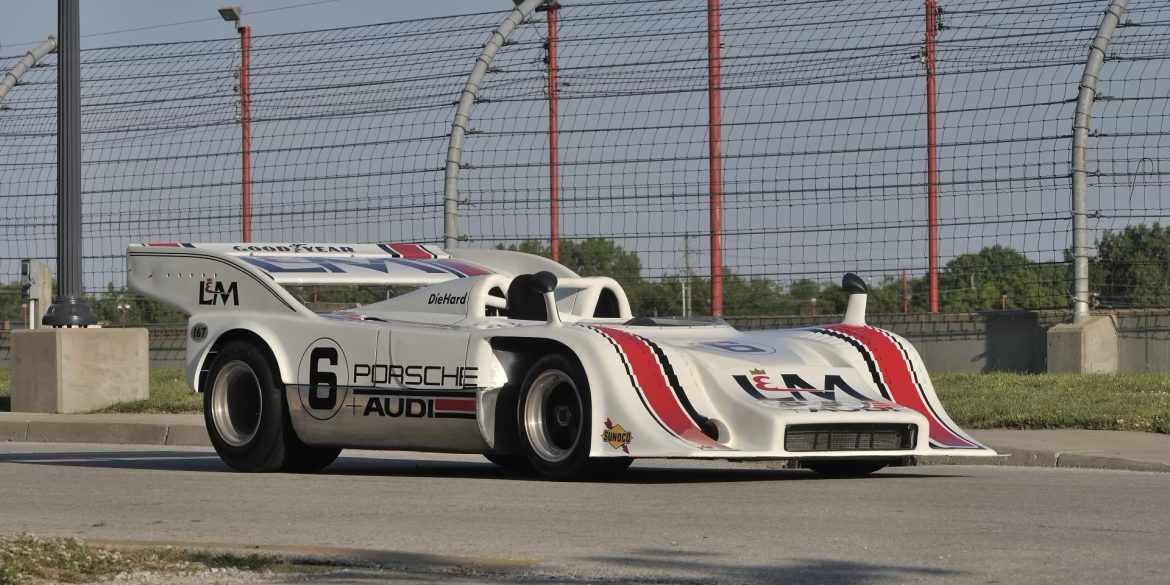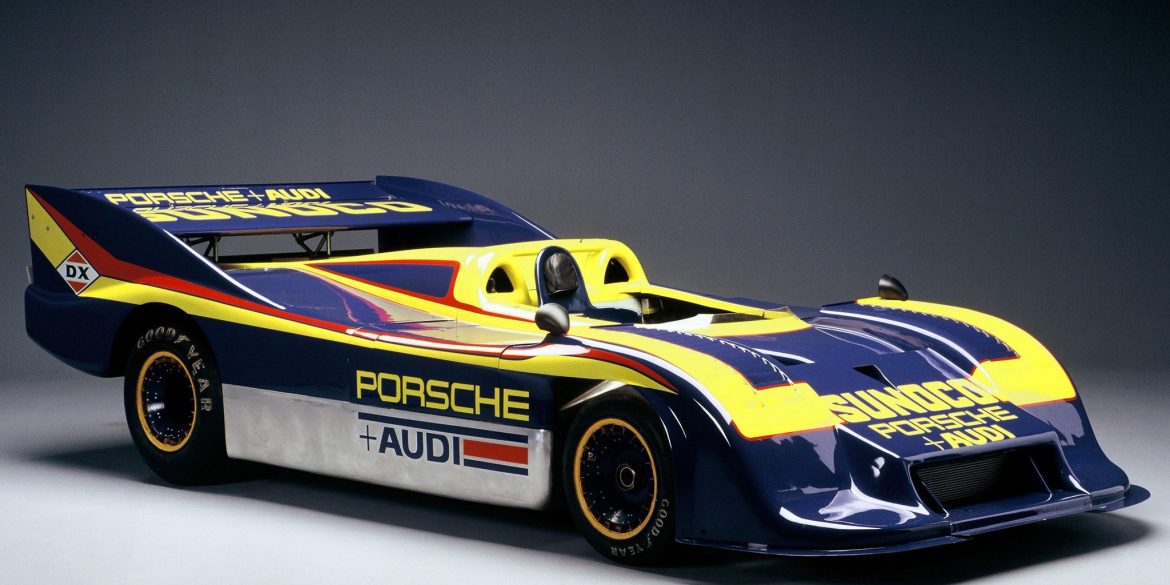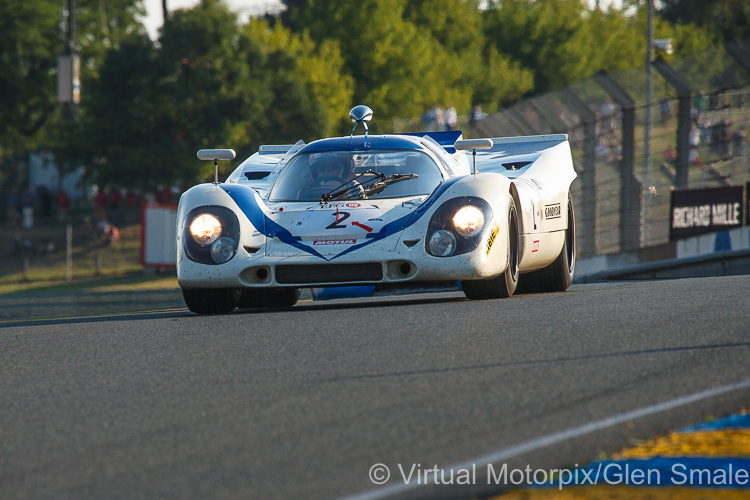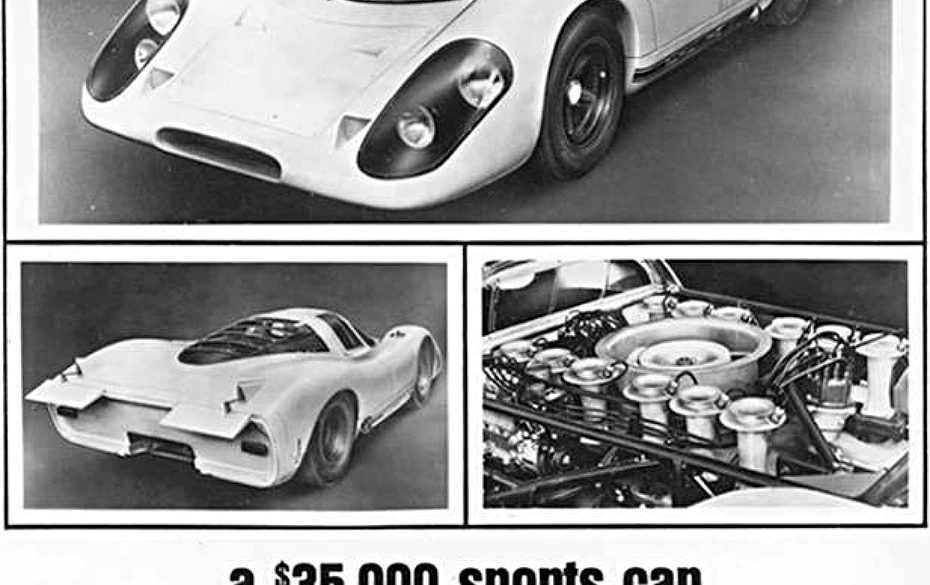The Martini team run by Hans-Dieter Dechent had three cars, two to race, and one T-car. The #3 was driven by the two Austrians, Helmut Marko and Rudi Lins Some say this was the best Daytona 24 hour ever. It certainly was the closest finish up to that point in time....
Porsche 917
Porsche 908, 909 and 917 racing cars were the brainchilds of engineering genius Ferdinand Piëch, the grandchild of Ferdinand Porsche and nephew of Ferry Porsche. The 917 was the only Porsche model produced with the 12-cylinder engine and experimentally even with the 16-cylinder. When the new rules for the International Championship for Sports Cars were made public at the end of 1967, the team in Stuttgart-Zuffenhausen decided to build a new race car for the under-five-liter class. As the successor to the successful 907 and 908 types, the 917 got an air-cooled twelve-cylinder engine. Powered by the Type 912 flat-12 engine of 4.5, 4.9, or 5 litres, the 917/30 Can-Am variant was capable of a 0-62 mph (100 km/h) time of 2.3 seconds, 0–124 mph (200 km/h) in 5.3 seconds. The long tail Langheck version had a maximum measured top speed of 362 km/h (225 mph). It was dominant, scary and probably the most insane racecar ever built. See all our Porsche 917 Research.
All
The Porsche 917-001 will be shown in the Porsche Museum for the first time in its original condition My 2019 European Expedition had been organised for some months, which was to take in the WEC Spa-Francorchamps 6 Hours (1-4 May) followed by almost a week in Stuttgart (5-10 May). It...
Le Mans 24 Hours, 31 May-1 June 1986: Start of the race – Porsches dominate the lead group In Part 1, Stories from Le Mans – with a Porsche flavour, our intrepid scribbler who hails from that beautiful part of South Africa, the Western Cape, shares with us some hilarious...
On April 28, 1975 a one-off Porsche 917 race car left the Weissach development center. It headed not for a track – like every 917 before – but instead, and for the very first time, it took to public roads. It was an audacious adventure driven by the passion of...
Background The Porsche 917, unveiled in 1969, stands as a testament to Porsche’s commitment to innovation and their quest to conquer the 24 Hours of Le Mans. Its debut at Le Mans in 1969 revealed its formidable speed and reliability, yet aerodynamic issues resulted in high-speed instability. After major changes,...
World famous icon to be auctioned in 2025 One of the most recognizable race cars of all time is coming to auction. Built by Porsche KG in 1969 for FIA-Homologation, the halo racer was converted to short tail specification by the factory in April 1970. The racer was then purchased...
Mention the name Porsche and motor racing, and minds immediately focus in on one of the famous race cars to pass out through the gates of the Stuttgart manufacturer. Depending on your age or favoured period in racing, the number of ‘best’ racers will be many and varied. However, the...
If you would like to own a piece of motor racing history, no, make that a very significant piece of racing history, then pay attention. Porsche 917 K (chassis #917-024), once owned by the master of the 917 himself, Jo Siffert, was part of his private collection. 917-024 did not...
The undisputed King The Porsche 917, conceived in the late 1960s, emerged from Porsche’s strategic intent to conquer the World Sportscar Championship, particularly the 24 Hours of Le Mans. This ambition materialized through exploiting a loophole in the homologation requirements, allowing the creation of a vehicle with unprecedented speed and...
Gulf 917 by Jay Gillotti – © Dalton Watson Fine Books There is little that you can add to the vast history that is already known about the Porsche 917, or so you might have thought. But the quietly spoken Jay Gillotti, has pieced together a valuable and mightily useful...
1973 Vasek Polak Porsche 917/10-018 Cam-Am Spyder driven by Jody Scheckter Jody Scheckter was born in East London on the east coast of South Africa, a sleepy seaside town that actually carried the honour of being the country’s motorsport centre up until the early 1960s. In 1973, Scheckter, by then...
Simeone Foundation Museum – 1970 Porsche 917-043 While diplomats and cartographers may technically show the roads around Le Mans as French soil, Porsche has laid claim to the winding bit of pavement that comprises the race track and especially victory lane. Since 1951, when a silver Porsche 356 clocked up...
Chassis #019 Campaigned by the Martini Racing Team in 1971, chassis #019 has been preserved in the same unrestored condition as when it finished the Spa 1000km race. This 917K (Kurzheck or short tail) competed in both the 1970 and ’71 seasons, racing with Porsche Salzburg during its first year...
#21 Martini Porsche 917 LH (chassis #042) was driven by Gerard Larrousse and Vic Elford in the 1971 Le Mans 24 Hour race – DNF, lost engine cooling fan From 1964 through to 1969, Porsche lifted its game from being a class winner to setting international lap speed and endurance...
A Brief History In mid-1967 the International Automobile Federation (FIA) announced that it had decided to modify the regulations pertaining to the Sport Prototype, Sport and Gran Turismo categories. As a result, the World Brands Championship was on the brink of the greatest crisis in its history. Many were the...
Without question, Ferdinand Piëch’s crowning glory came with the arrival of the Porsche 917 in 1969. This race car brought Porsche the one trophy that was missing from its trophy cabinet, the Le Mans 24 Hours. Remember, this was a time of great change in many aspects of life as...
Porsche 917 Factory Racing In 1969 Porsche’s new 917 was never intended to be ready for the two Florida races, Daytona and Sebring, at the beginning of the 1969 season. As it happened, the 917 also missed the first two European races of the Championship for Manufacturers, namely Brands Hatch...
Story by Glen Smale. All images © as stated in the book & on the DVD Brilliant…just brilliant!! I don’t often start a book review in this manner, in fact I can’t remember when I last did so, but this book and DVD set certainly deserve such a response. No...
Porsche 917 Sales Brochure The Porsche 917 is one of the most legendary race cars in motorsport history, known for dominating endurance racing and securing Porsche’s first overall victory at the 24 Hours of Le Mans in 1970. Built to comply with FIA’s Group 4 homologation rules, Porsche was required...
© Porsche 917 – Zuffenhausen’s Le Mans and Can-Am Champion Porsche 917 – Zuffenhausen’s Le Mans and Can-Am Champion, is the third title we have reviewed in the Ludvigsen Library Series. The other two have been Porsche Spyders 1956-1964: Type 550A, RSK and 718 models, and the White Racers from...
1970 Porsche 917 ‘Interserie Spyder’ Pictures...
No Subscription? You’re missing out Get immediate ad-free access to all our premium content. Get Started Already a Member? Sign in to your account here....
By 1969, Porsche develops the 917 Spyder with a view to competing in the extremely popular North American racing series, the Canadian American Challenge Cup (Can-Am). Three units featuring 4.5-litre twelve-cylinder naturally aspirated engines are constructed in Zuffenhausen, and Jo Siffert takes one to the US to compete in the Can-Am races, ultimately placing fourth overall. The car becomes known as the 917 PA Spyder, with “PA” standing for “Porsche + Audi” as they are the two sales organisations in the US at the time.
Vasily KOSTIN A cage of thin aluminum tubes, lightweight skin, double wishbone suspension and a crazy five-hundred-horsepower engine — this was the legendary Porsche 917 prototype, which forever inscribed the Porsche name in the history of Le Mans marathons. This year, the “nine hundred and seventeenth” turns forty: it’s high...
The Group 7 class in CanAm was virtually unlimited with regard to regulation, so Porsche was free to try many different avenues to source extra power. Two main themes were explored: the first was to go into uncharted territory and turbocharge engines with an exhaust-driven turbine. Eventually this was the chosen route, but it didn't reach fruition until a larger 16-cylinder engine was tried.
1971 Porsche 917 16-Cylinder Prototype Pictures & Gallery...
Porsche 917 Turns 40 Porsche launched the 917 40 years ago and it’s still their most important racecar to date. This dangerous, yet successful machine gave Porsche victory at Le Mans and all the other international races of its time. Porsche started their long 917 race program in 1969 with a...
In 1996 the 30 years of the Canadian – American Challenge Cup series were celebrated, better known as CanAm and which only ran for 9 seasons (1966-1974), although it stood out for using the cutting edge technology of the moment. The CanAm series gave more than enough action to keep it in the memory of the...
Some great work by one of our colleagues who managed to put together the chassis numbers for all the Porsche 917s. Chassis Number Notes Active Years Team Details 917-001 First 917 to appear in public, at the Geneva Salon in March 1969. Used for testing and announcement of partnership with...
The Porsche 917 – What They Said We found some great interviews from back in the day on what drivers thought about driving the mighty 917. Below we took excerpts and quotes from the drivers who were brave enough to drive the Porsche 917. Brian Redman The below appeared in...
Although the longtail 917 was introduced first, it was meant only for the Le Mans. This meant, the short tail 917 K ("Kurz" in German for short) was raced first. The only engine available in 1969 was the 4.5-litre flat 12. The factory team enters one 917 K also for the Nürburgring 1000 km race, where it scores 8th. The factory team would not enter 917 K for racing anymore in the season, only private teams will.
1970 Porsche 917 K Pictures...
No Subscription? You’re missing out Get immediate ad-free access to all our premium content. Get Started Already a Member? Sign in to your account here....
The 917 Kurzheck Coupé (917K) first appeared in 1970 and contributed more to the Porsche 917 story than any other variant. It was a high-down force version that featured a cut-off tail for increased downforce. This reduced the cars top speed, as much as 30 mph. Le Mans winner 1970, Interserie winner 1970 and Manufacturers' World Championship for Porsche in 1970.
1971 Porsche 917 K Pictures Visually, the “shark fins” on the tail look awesome, but they also gave the Porsche 917 KH 1971 greater directional stability and reduced wind resistance by 11 percent. ...
No Subscription? You’re missing out Get immediate ad-free access to all our premium content. Get Started Already a Member? Sign in to your account here....
The “shark fins” on the tail gave the Porsche 917 KH 1971 greater directional stability and reduced wind resistance by 11 percent. In 1971 a veritable armada of six Porsche 917s started at Le Mans. The car with start number 22 was special. The white race car with the characteristic Martini stripes had the new “shark fins” on the tail that Porsche had first used in pretraining in April. This 917 was also the first Porsche with a magnesium tubular frame to be used in a race.
Porsche 917 LH-69 Pictures...
For the 1969 racing season an absolutely new Porsche 917 with 4.5-litre 12-cylinder engine was created. Ferdinand Piëch relied on the skilfulness of Hans Mezger, who was responsible for the overall construction of the vehicle and its engine. The aim was to create the fastest racing car ever. Short and long tail versions were developed, called as the 917 K ("Kurz" = short in German) and the 917 LH ("Langheck" = long tail). The first car was assembled in December 1968.
1970 Porsche 917 Langheck Pictures...
No Subscription? You’re missing out Get immediate ad-free access to all our premium content. Get Started Already a Member? Sign in to your account here....
With the aerodynamic instability of the 917 in the 1969, two separate configurations were used in 1970. These were the short-tail Kurzheck version and the less common Langheck or long-tail. Most of the 917's accolades were achieved by the 917 Kurzheck, leaving the Langheck a less popular, but ultimately just as potent contender.
1971 Porsche 917 Langheck Pictures...
No Subscription? You’re missing out Get immediate ad-free access to all our premium content. Get Started Already a Member? Sign in to your account here....
Like the 917 LH of 1969 and 1970, the 1971 version was also made for one race only - the 24 hours of Le Mans. The 917 LH-70 had already proved that the body was excellent for Le Mans, so the aerodynamical modifications for 1971 were mild. The front was modified and the rear wheels were covered. The 917 LH-70 that scored 2nd at the 1970 Le Mans 24H (chassis 917-043) was modified for the Le Mans 1971.
A total of 30 drivers managed to win races during the four-year period between 1968 and 1971. Here’s the breakdown: The 30 drivers who won at least one race with points for the World Brand Championship formed, among themselves, a total of 26 different winning pairs. These are the most successful:...
The Engines Engine Type 912 – 12 Cylinders The Porsche House made it the norm since 1967 to participate in the tests for the Manufacturers’ Championship only with new machines, because the cost of developing and building them was partially offset by the sale of the used units at the end of each season. This...
1969 Porsche 917 LH poses outside the workshops in Stuttgart-Zuffenhausen © Porsche Werkfoto The world has become obsessed with anniversaries or facts that you can leverage, in order to bring your message across. And that is also true to some extent about this account of a legendary race car, but...
The fabulous story of this car’s life begins in 1970 with the construction of chassis #021, one of the first batch of twenty-five 917s to be built. In April 1970, the newly completed chassis #917-021 was sold to the Finnish AAW team, finished in the red and yellow colours of...
1971 – 1972 Porsche 917/10 Pictures...
Images by: Virtual Motorpix/Glen Smale and Corporate Archives Porsche AG The Porsche 917 was the culmination of a line of race cars produced by the Stuttgart manufacturer during possibly the busiest decade, from 1964 to 1973, of its (by then) short existence. Just 21 short years after Porsche opened its...
The first turbo-Porsche, Can-Am winner 1972, Interserie winner 1972, 1973. The first ever publically seen turbocharged Porsche was the 917/10 Turbo with chassis number 917/10-011. It was entered for the June 11, 1972 Can-Am Mosport race. Mark Donohue was fastest in the qualification with it, but scored second in the 80 laps race after the 8.1-litre McLaren. The Porsche Turbo era had begun. Eight 917/10 were racing in 1972 in Can-Am and in Interserie.
Jo Siffert was the first to take the 917 to Can-Am championship. The car he used in 1969, was the 917 PA Spyder. Although he participated in one Can-Am race in 1970 with a 917 K, that season he skipped. He was back from mid-season 1971 and now with the 917/10. Only two 917/10 were created in 1971. The chassis 001 was used for testing and the 002 by Siffert. He took part in six races out of ten, managed podium finishes three times and scored 4th in the season, like in 1969.
No Subscription? You’re missing out Get immediate ad-free access to all our premium content. Get Started Already a Member? Sign in to your account here....
The 1972 917/10 was similar in its design to the 908/03, but, of course, had the 12-cylinder engine instead of the 3-litre flat-8. The 917/10-72 was first seen at the Interserie Nürburgring race on April 3. It was the chassis 004 car of Leo Kinnunen and Keimola Racing Team AAW. Kinnunen scored 4th in the first race, but would win the championship by the end of the season. The second Interserie race was at Monza on May 1st and that race was won by chassis 917/10-002 and Willy Kauhsen.
An attempt to blend the best aerodynamic characteristics from both the short-tailed 917 K and long-tailed 917 LH led to the the 917/20, otherwise known as the Pink Pig. The car's combination of a long body, stubby face, and wide hips gave it a pig-like look, which inspired Porsche designer Anatole Lapine to give the car a pink paint job with butcher cut lines covering the exterior. It was hugely popular at the 1971 Le Mans race, and was the fastest in qualifying and nearly came in fifth place, before a brake failure caused it to crash before the finish line.
The 917/20 Turbo is a confusing car - its chassis number reads 917/30-001, but it is not the real 917/30. In its first race it was called as the 917/10 Turbo. Sharp eye can detect that it was not just the 917/10 Turbo, but an evolution of it. At the same time it was not the evolution of the 1971 Le Mans 917/20. Still, the car should not be called as the 917/30 to distinct it from the "real" 917/30 Can-Am racers and in 1974 it was decided to call it as the 917/20 Turbo.
No Subscription? You’re missing out Get immediate ad-free access to all our premium content. Get Started Already a Member? Sign in to your account here....
‘Scary’ is not an adjective uttered often by seasoned racing drivers in the company of their peers, but it tripped easily from the lips of the small band of heroes who drove Porsche’s first 12-cylinder Type 917 sports cars. Few racing cars since the hairy-chested Mercedes-Benz and Auto Union Grand...
1973 – 1974 Porsche 917/30 Spyder Pictures...
The final evolution of the 917 was created after Ferdinand Piëch had left the Porsche company in 1972. Two complete 917/30 Can-Am cars with 2500 mm (98.4") wheelbase were made for Roger Penske Enterprises racing team. They were chassis 917/30-002 and 003. The 001 car was not a real 917/30 and was raced in Europe at the Interserie. The Can-Am 917/30 had a 5.4-litre flat 12-cylinder twin-turbo engine which produced so much power that nobody really knew how much.
Porsche 917/30-003 1975 Team Penske In 1976 Penske sold the chassis to privateer Otis Chandler. Pictured Riverside, 1979. Porsche 917/30-003 test drives ...
50 years of the Porsche 917 Anniversary The most famous racing car of all time made its debut at the Geneva Motor Show on 12 March 1969, and the Porsche Museum is celebrating the landmark birthday with plans to restore the first 917 ever made to its original condition, as...
Porsche – Graphisme 917 by Stéphane Coradi © Virtual Motorpix/Glen Smale Porsche Graphisme 917: This is Stéphane Coradi’s second publication in less than a year, the man is irrepressible. His enthusiasm for the Stuttgart marque knows no bounds, and combined with a unique artistic talent, this new book is quite...
With the aerodynamic instability of the 917 in the 1969, two separate configurations were used in 1970. These were the short-tail Kurzheck version and the less common Langheck or long-tail. Most of the 917’s accolades were achieved by the 917 Kurzheck, leaving the Langheck a less popular, but ultimately just...
The 917 Kurzheck Coupé (917K) first appeared in 1970 and contributed more to the Porsche 917 story than any other variant. It was a high-down force version that featured a cut-off tail for increased downforce. This reduced the cars top speed, as much as 30 mph, but it helped the Porsche win...
After claiming two Le Mans victories with the iconic 917 Kurzheck, Porsche’s Weissach engineers converted it into a Group 7 contender by 1973, boasting over 1000 bhp. The result was the L&M Porsche+Audi 917/10, driven by George Follmer and backed by Penske, which triumphed in the 1972 Can-Am Championship, outshining...
The ultimate expression of CanAm’s unique sky’s-the-limit approach to technical regulations, this 1200bhp twin-turbo monster was a sensation, rubbing salt into the opposition’s wounds by totally dominating the 1973 season after its predecessor. The Porsche 917/30 was a derivative of the 917/10 and it was the first real turbocharged racing car developed to...
Last weekend, we would have been at the Le Mans Classic had the coronavirus pandemic not intervened. Now, thanks to this global medical crisis, all sports and major events involving large public gatherings have had to be either cancelled or postponed. One of our favourite historic race car meetings, the...
With the 911 GT3 RS Tribute to Jo Siffert, Porsche is paying tribute to the late Swiss racing driver while also commemorating the first victory of the legendary 917 almost 55 years ago. On 10 August 1969, Siffert and Kurt Ahrens won the first international 1,000-kilometre race at the Österreichring...


